In the previous sequel of my stories about the travel around Thailand in 2023, I stopped in the middle of my sightseeing of the Wat Mahathat temple. However, I won’t immediately continue describing my visit to the remains of this temple now; instead, let me first briefly reflect on the history.
Ayutthaya is a town located about 80 km north of Bangkok, but it is primarily known as the capital of the mighty Siamese kingdom that existed from 1351 to 1767. At the time of the founding of the Ayutthaya kingdom, the previous Siamese kingdom, Sukhothai, with its capital about 400 km north of Ayutthaya, was already in a state of decline, thus paving the way for the formation of this new kingdom.
Historically, there were four Siamese kingdoms and to avoid confusion let me say right away that their capitals shared the same name as the kingdoms or vice versa – the kingdoms were named after their capitals. Be as it may, the first Siamese kingdom was the Kingdom of Sukhothai (1238-1438), the second one was the Kingdom of Ayutthaya (1351-1767), the third was the Thonburi Kingdom (1767-1782) and the fourth was the Rattanakosin Kingdom (1782-1932).
Although the Chakri dynasty ruled the present-day Thailand even during the time of the Rattanakosin Kingdom, it is considered that with the Siamese Revolution of 1932, the transition from an absolute monarchy to a constitutional monarchy officially marked the end of the Rattanakosin Kingdom, concluding an 800-year era of absolute monarchy. The new state was named the Kingdom of Siam, but in 1939 that too was changed and since then this Southeast Asian country has been called the Kingdom of Thailand.
But, let me go back to the Kingdom of Ayutthaya. Its capital was founded on a large island between two rivers, formed by the digging of a canal connecting the two rivers before they reached their estuaries. The island was approximately 4 km long and 2 km wide. During the Ayutthaya Kingdom period, the island housed the royal palace and numerous temples, while the city also constituted a very important trade centre. Upon its foundation, Ayutthaya first took over the control from Sukhothai and then began expanding by attacking its neighbours. While it may not have been the largest state in the region, it was certainly the most powerful.
One of the key factors contributing to this power was trade. The strategic location of Ayutthaya the capital, surrounded by rivers that facilitated excellent connections with neighbouring kingdoms, played a vital role. But, the trade opportunities also attracted Europeans, initially the Portuguese, Dutch and French. Traders from the Middle East and various Asian countries, including China and India, also participated. Ayutthaya thus became not only a large and wealthy, but also a cosmopolitan centre in this part of the world.
However, in the early 18th century, the rulers of Ayutthaya closed their borders to most Europeans, though the trade with Asians, especially with China, continued. This did not diminish the high status and wealth of the capital and the entire kingdom in any way.
Meanwhile, after a series of conflicts, the Burmese finally conquered the Kingdom of Ayutthaya in 1767, destroying its capital by burning it to the ground and forcing the population to disperse. The successor to the once-mighty Kingdom of Ayutthaya, King Taksin the Great (reigned 1734-1767), decided not to rebuild the old capital, but instead founded a new one on the western bank of the Chao Phraya River (a part of the present-day Bangkok), as I have previously written about in Part 9 of the Thailand travel stories (see: https://www.svudapodji.com/en/thailand-9/).
Today, the remains of numerous temple complexes, palaces and other structures can be seen here, and the entire Historic City of Ayutthaya is on the UNESCO World Heritage List.
Now, let me return to the exploration of Wat Mahathat temple with the map of my visit as a reminder:
The layout of the main structures within this temple complex is the same as that of the adjacent Wat Ratchaburana temple, which I wrote about in the previous sequel of the story. Along the same axis, starting from the eastern front, there are the royal vihara of rectangular shape, followed by the main prang surrounded by a square-shaped cloister and, finally, there is the ubosot, also of rectangular shape. Even the size of the bases of these structures is the same or almost the same. The rest of the temple complex is filled with remains of numerous chedis, prangs and other smaller structures, some of which are better preserved and some to a lesser extent.
After taking pictures with the Buddha Head and observing the smaller structures nearby, it was the time to explore these larger structures. First, I came to the royal vihara, where today much fewer remains can be seen compared to the vihara of Wat Ratchaburana. However, there is a very interesting wall on the south side of the structure. It is not very clear in the photo, but the there are “slots” created in the wall with sculptural decorations in between.
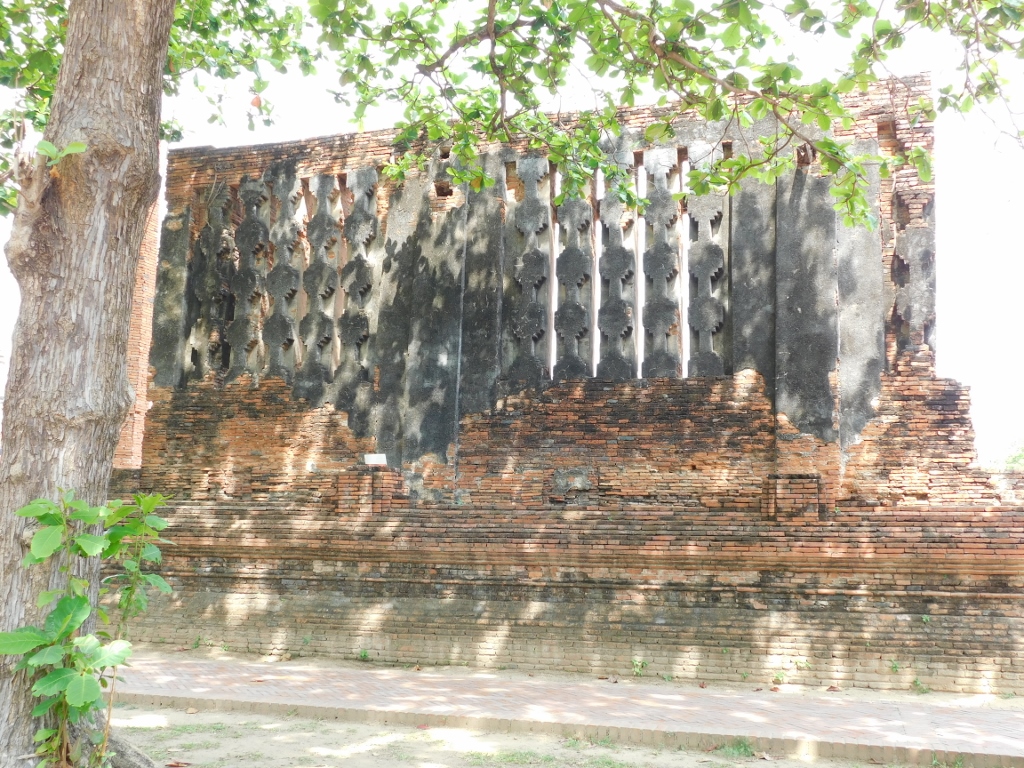 Wat Mahathat, south wall of the royal vihara
Wat Mahathat, south wall of the royal vihara
When I entered the vihara area, I could see a platform where the surviving remains of the Buddha figures are placed.
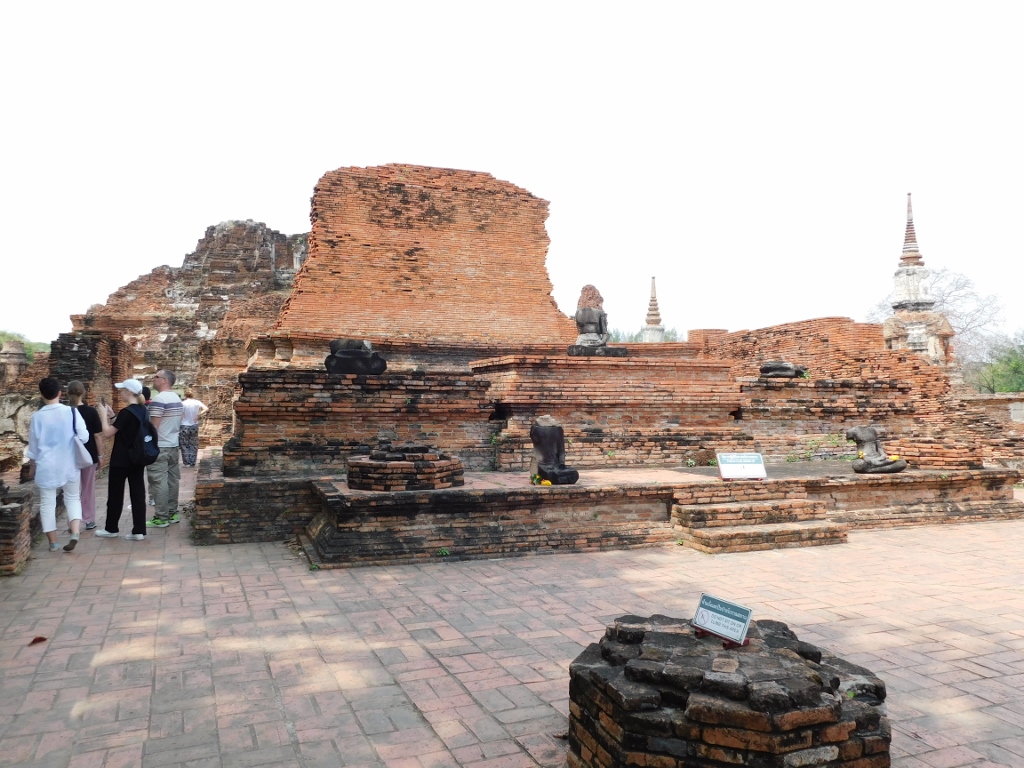 Wat Mahathat, the royal vihara
Wat Mahathat, the royal vihara
Then I took a stroll around the square inner courtyard that surrounds the central prang or, rather, its remains, which is surrounded by the cloister.
 Wat Mahathat, view of the remains of the main prang and numerous other structures within the inner courtyard, as well as outside of it
Wat Mahathat, view of the remains of the main prang and numerous other structures within the inner courtyard, as well as outside of it
In the previous photo, you can see the partial remains of the main central prang. I have already mentioned in the previous sequel that this prang was nearly 50 meters high but, over time, due to various reasons, it collapsed several times and was periodically reconstructed. However, it is only partially restored now, allowing only the base with stairs to be visible.
Many significant artefacts were found inside the prang in 1956, inspiring thieves to find and take similar treasures from the Wat Ratchaburana temple, about which I have also written in the previous sequel. In any case, a large part of what was found or recovered from thieves can be seen at the local museum.
A cloister, a covered walkway that was connected to both the vihara in the east and the ubosot in the west, surrounds the main prang here as well. It represents a part of the architectural style of the Early Ayutthaya period. Remains of the surviving Buddha figures are arranged here in a way that they ‘face’ the central prang.
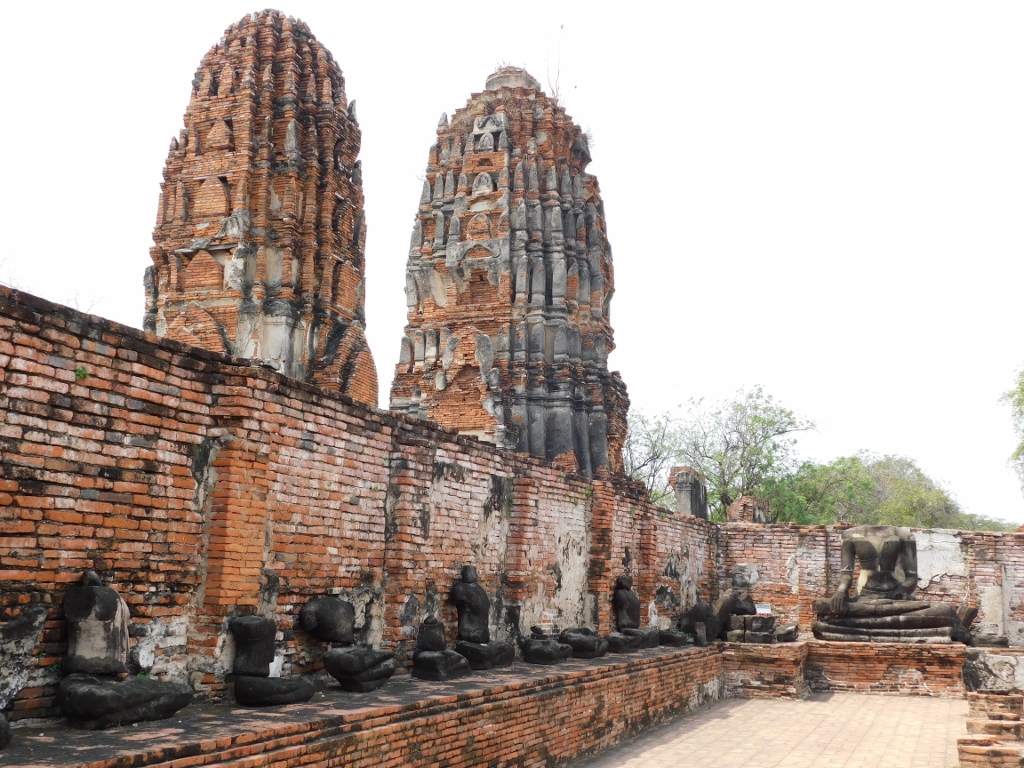 Wat Mahathat, a detail
Wat Mahathat, a detail
However, in the rear part of the courtyard leading to the ubosot, one can see a larger, well-preserved statue of the Buddha placed with its back to the main prang.
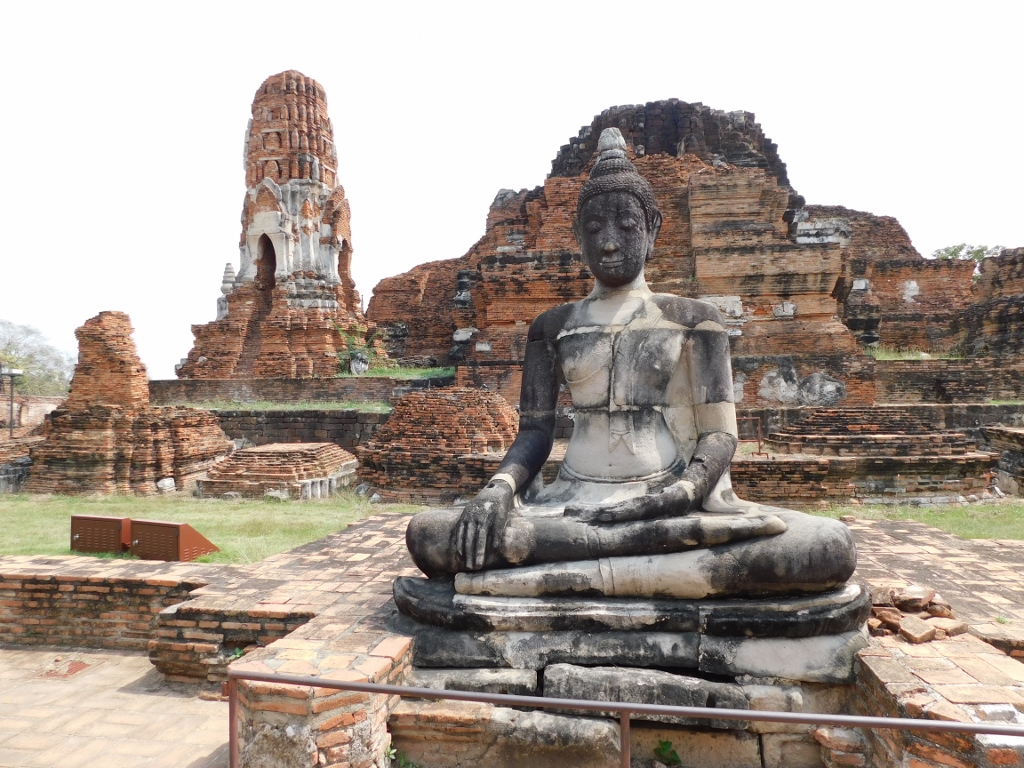 Wat Mahathat, a detail
Wat Mahathat, a detail
Within the temple complex, there is an enormous array of structures, as can be inferred from my photos. Exploring each one and examining every detail would require much more knowledge and time than I had. That’s why I slowly made my way towards the exit, capturing various interesting details that caught my eye along the way. For instance, a small vihara in the western part of the site, entirely constructed from brick and mortar, including the roof.
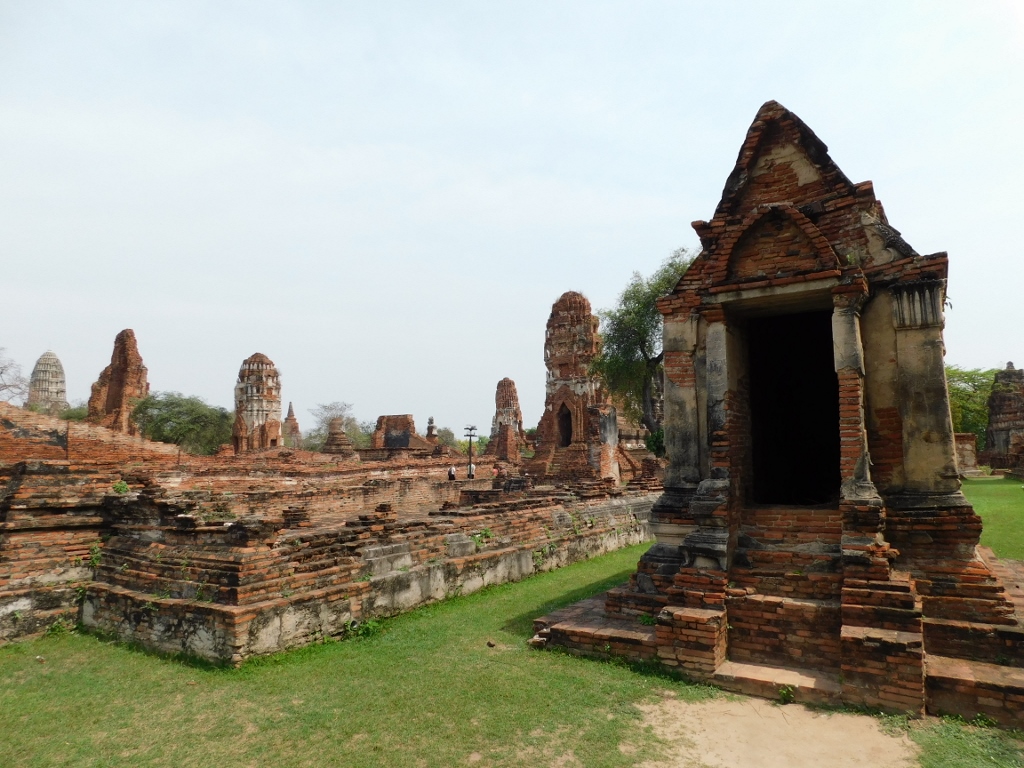 Wat Mahathat, a detail
Wat Mahathat, a detail
Then I reached the southern part of the site and following the visitor path, I passed by a couple of smaller prangs that are quite well-preserved, although one of them is noticeably tilted.
 Wat Mahathat, a detail
Wat Mahathat, a detail
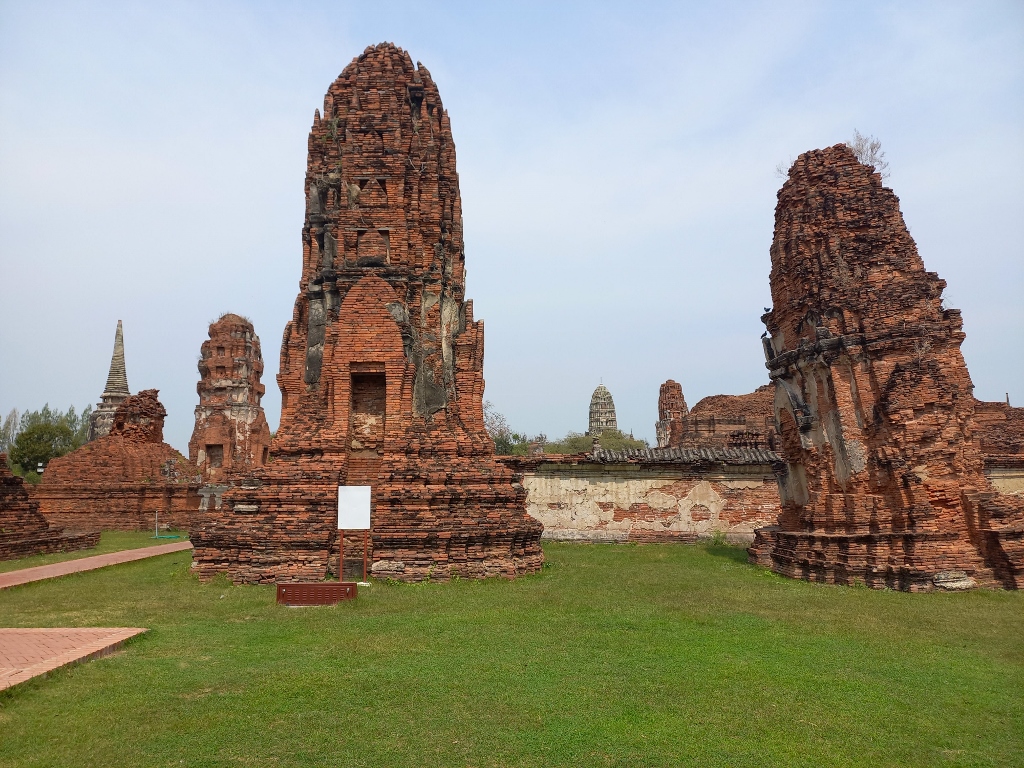 Wat Mahathat, a detail
Wat Mahathat, a detail
And then I proceeded along the path through Bueng Phraram Park, which features ponds and enough trees to provide occasional shade – a crucial relief when exploring the Ayutthaya site at noon. In the park, there are also remnants of a few smaller temples and I headed towards them. Along the way, I could once again see parts of Wat Mahathat in the foreground and the impressive prang of Wat Ratchaburana in the distance.
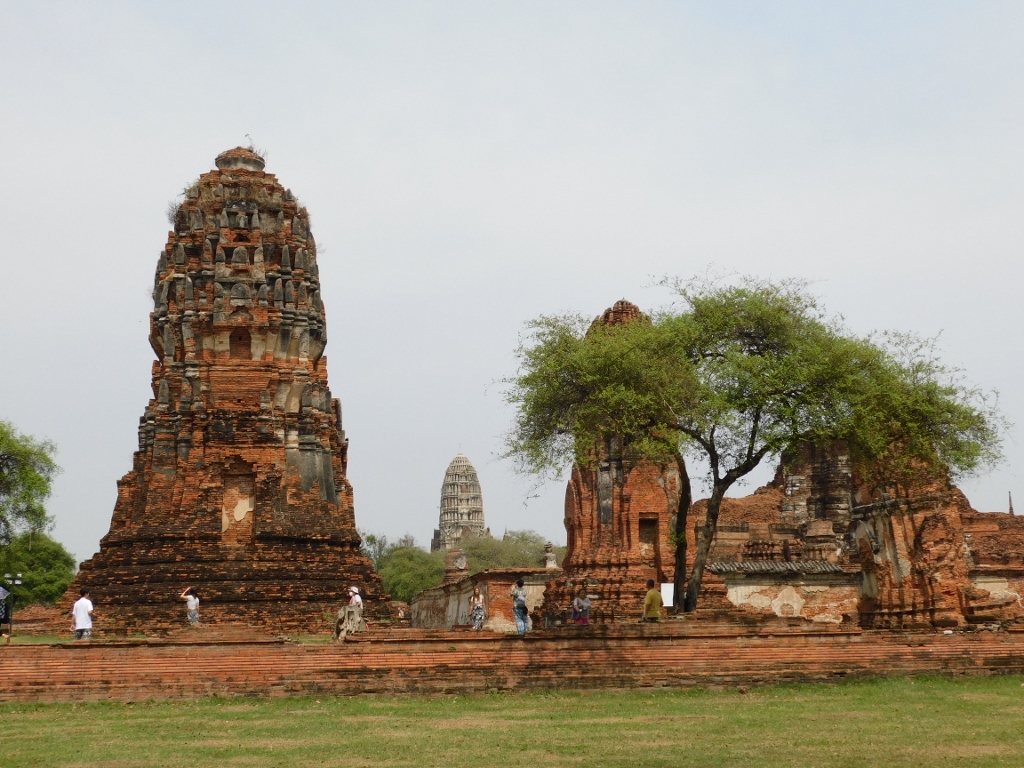 Ayutthaya, a detail
Ayutthaya, a detail
So, the path through the park led me to the remains of several smaller temples, but I don’t have any information about them. Still, it was interesting for me to see and take photos of them as I passed by or approached their vicinity.
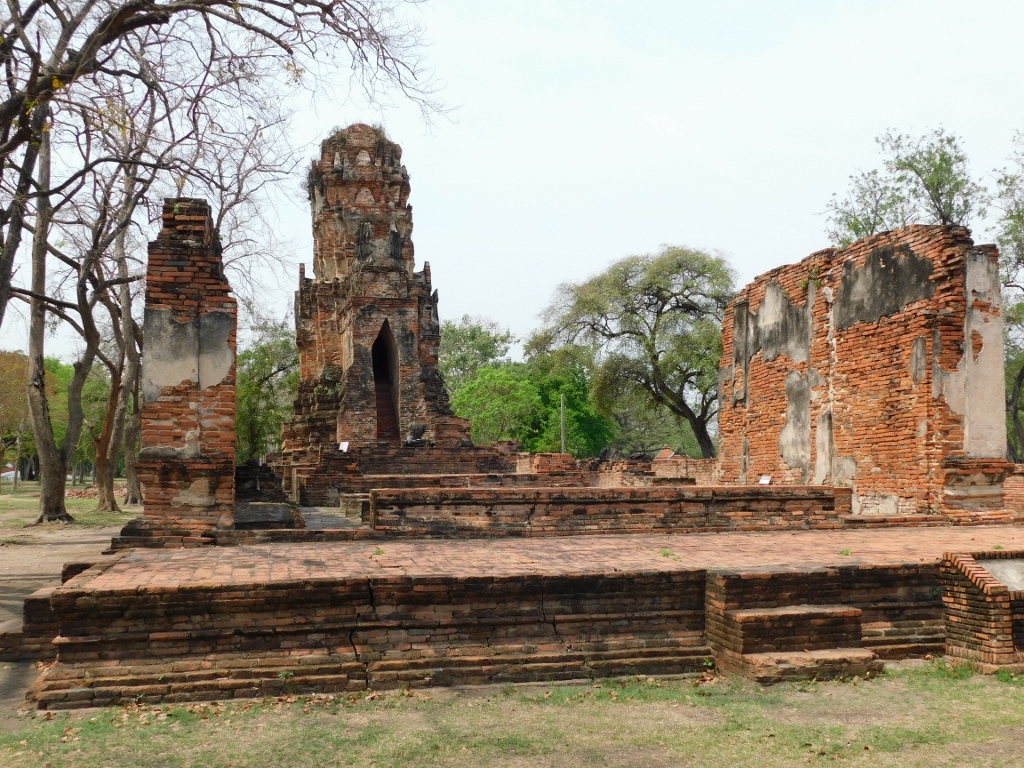 Ayutthaya: Wat Nok
Ayutthaya: Wat Nok
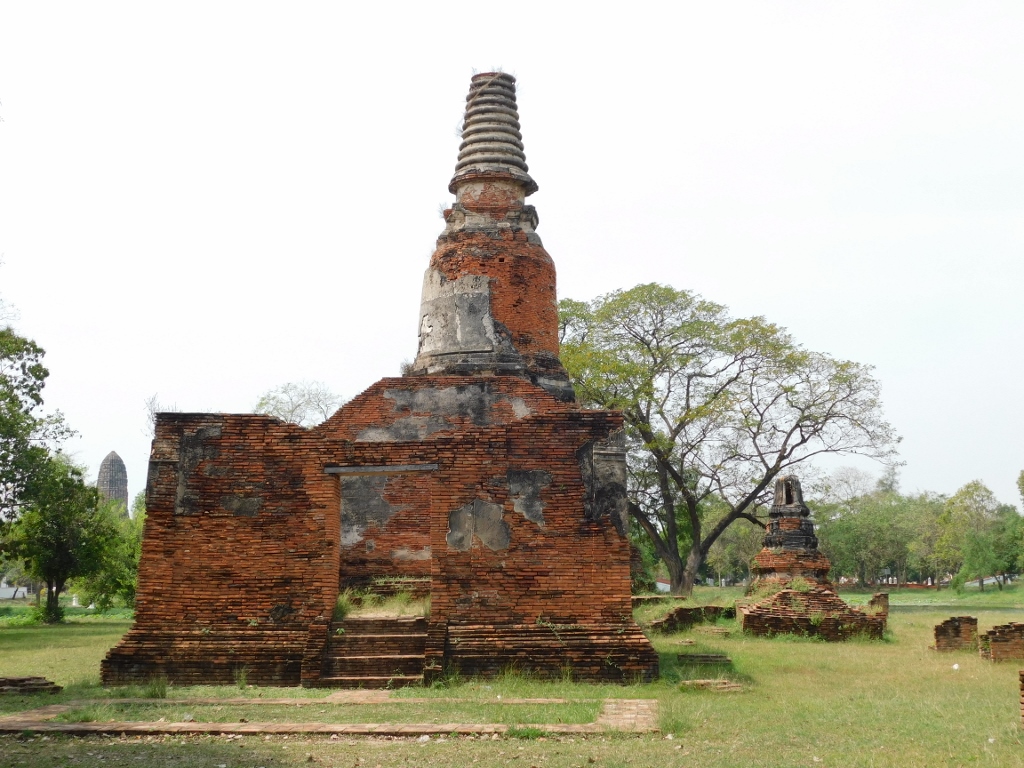 Ayutthaya: Wat Langkhadum
Ayutthaya: Wat Langkhadum
In the park, besides the water areas, there are also small islets easily accessible via charming bridges. The various temples can be seen both from up close and from a distance, adding to the picturesque scenery.
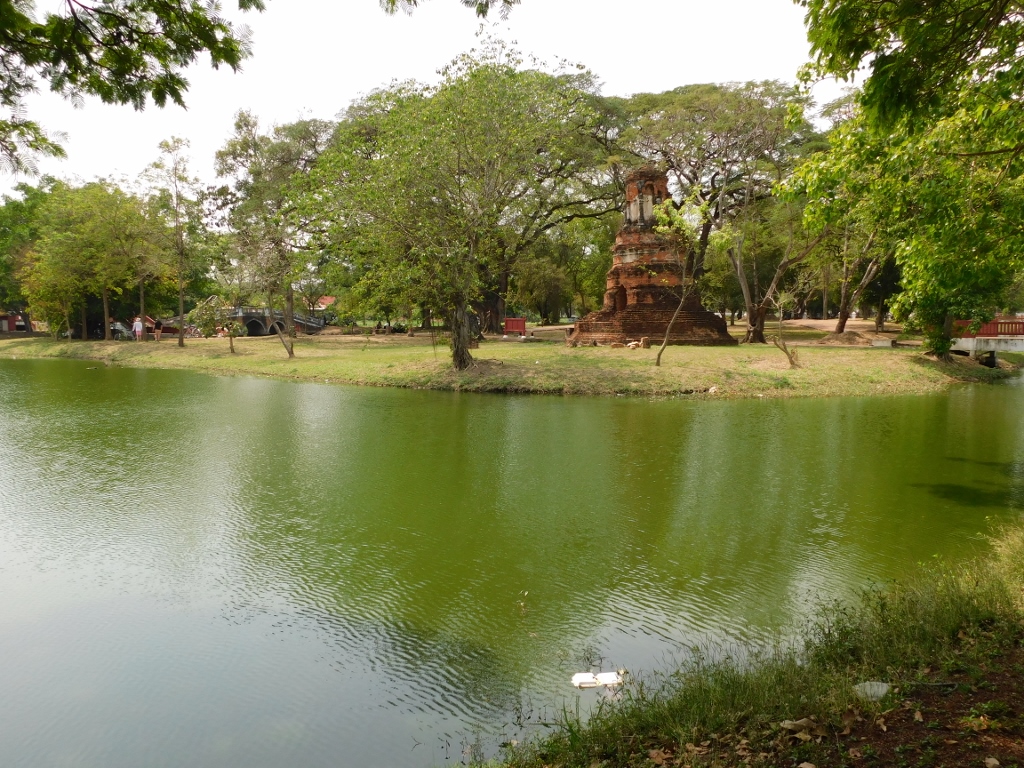 Ayutthaya: Wat Sangkhopat
Ayutthaya: Wat Sangkhopat
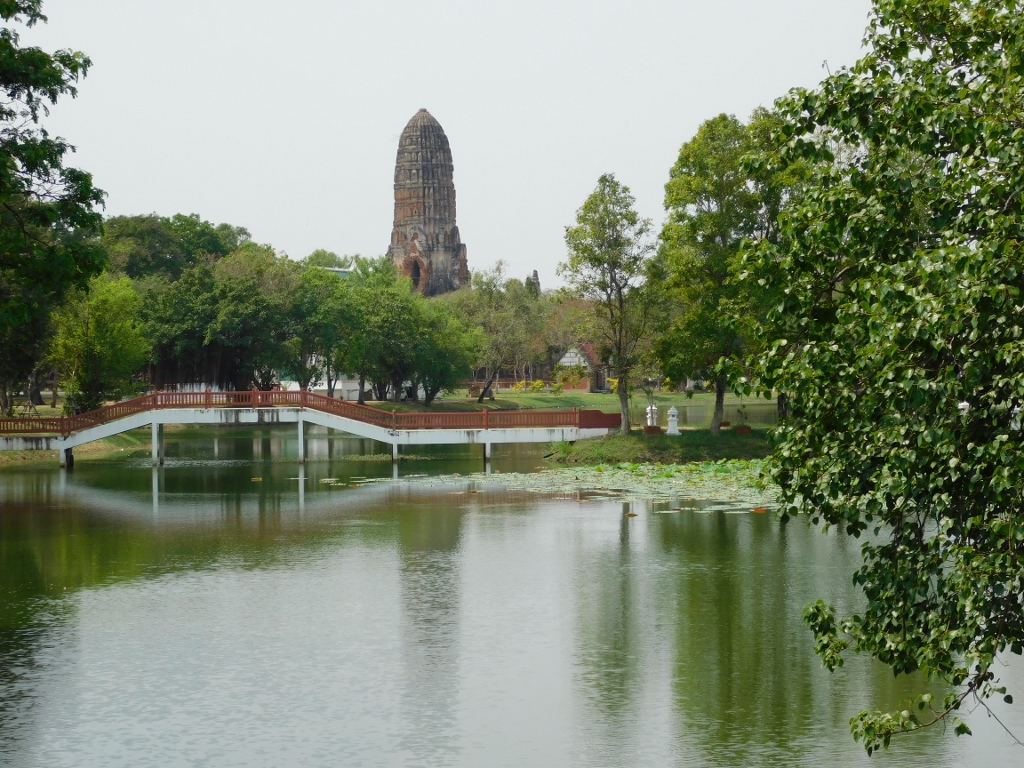 Ayutthaya: the prang of Wat Phra Ram temple can be seen in the distance
Ayutthaya: the prang of Wat Phra Ram temple can be seen in the distance
Some parts of these ponds are covered in lotus flowers, which is already a beautiful and interesting sight, especially when you see the lovely lotus blossoms emerging on the surface. By the way, although waterlilies and lotuses may seem similar, they are two entirely different plant species. This is a lotus or Indian lotus from the genus Nelumbo, while waterlilies belong to the genus Nymphaea.
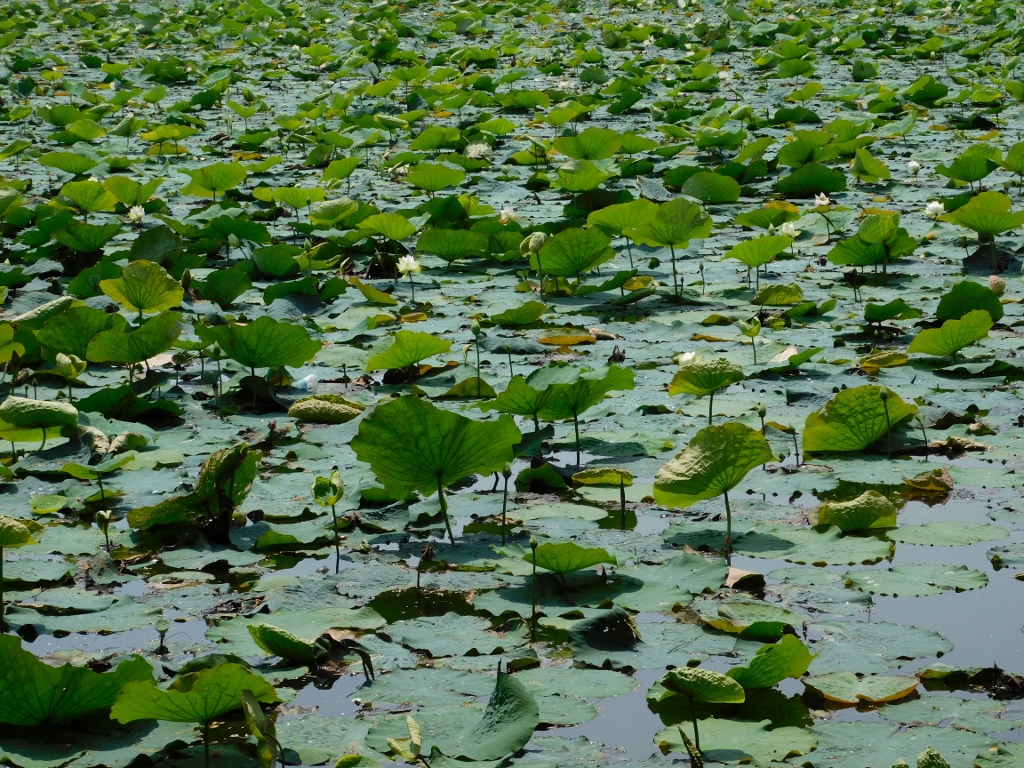 Ayutthaya: lotuses in the Bueng Phraram Park
Ayutthaya: lotuses in the Bueng Phraram Park
However, at one point, I noticed some movement among the lotus flowers and I realised that someone was there. I stopped and waited for a moment to capture what was happening. As far as I could tell, a person was picking the lotus flowers.
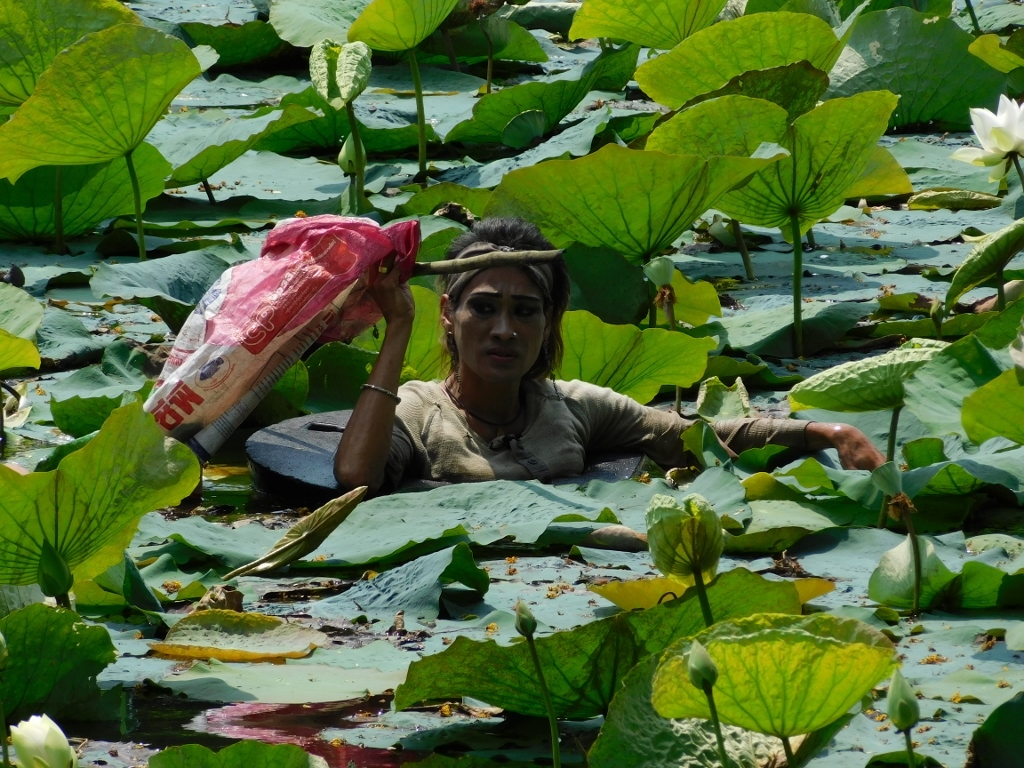 Ayutthaya: lotus picker in the Bueng Phraram Park
Ayutthaya: lotus picker in the Bueng Phraram Park
Lotus flowers are often brought to temples as offerings, but they are also regularly seen as a part of decorations in temples and on various objects, as they carry significant Buddhist symbolism. The highly important symbolism of the lotus is also conveyed as the form in the construction of different buildings. Namely, the aspiration of every individual should be spiritual development, which is like the lotus flower – starting from the bottom and the mud, breaking upwards and growing through murky waters, ultimately emerging into the light and transforming into a beautiful blossom.
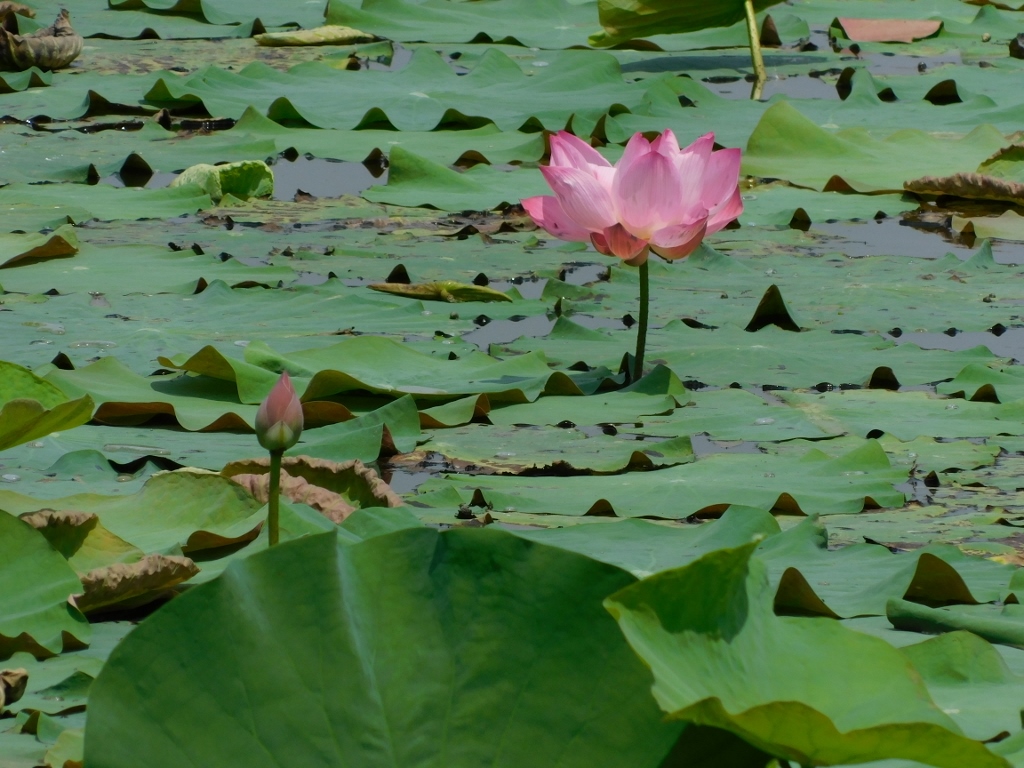 Be like a lotus flower
Be like a lotus flower
My next destination was Wat Phra Ram, but I initially approached it from the rear. The entrance there was closed, so I had to walk around the temple to find another entrance.
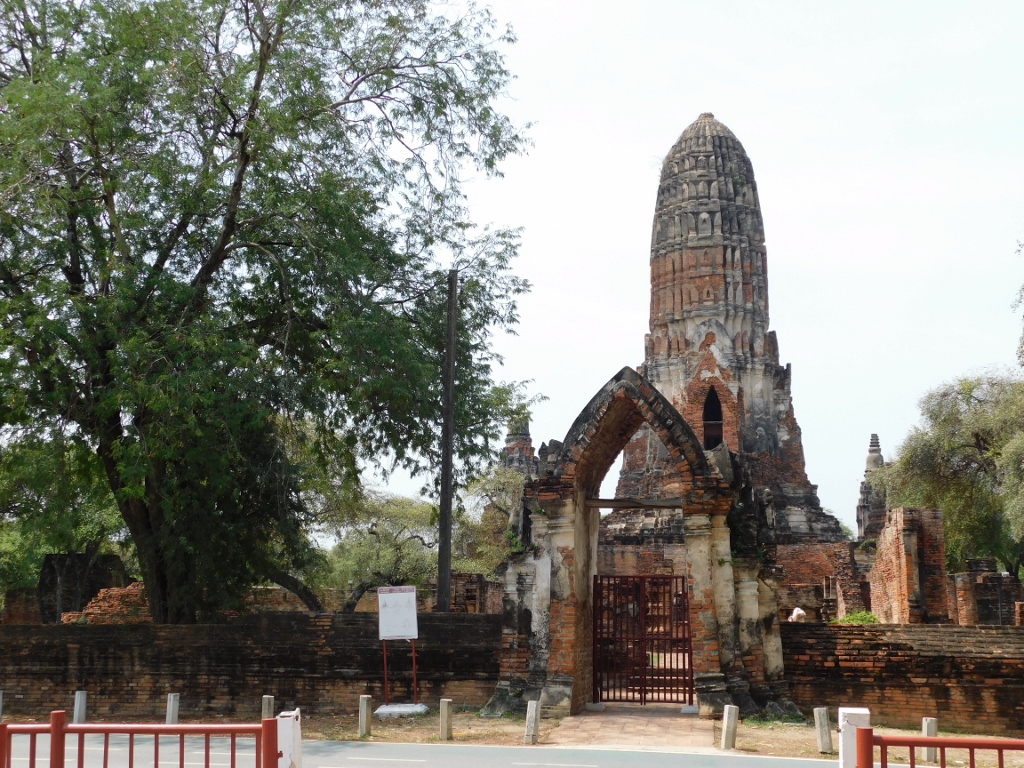 Ayutthaya: Wat Phra Ram
Ayutthaya: Wat Phra Ram
On the way to the temple entrance, I also came across a group of elephants strolling around, carrying those tourists who enjoy such experiences.
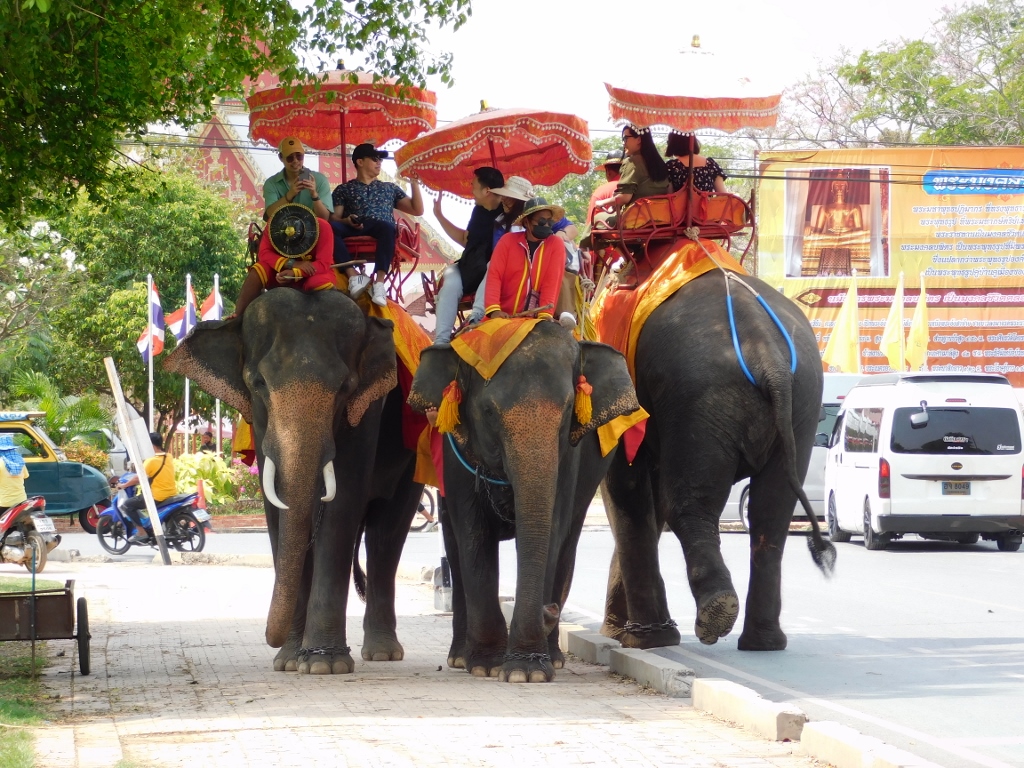 Ayutthaya: a detail
Ayutthaya: a detail
The construction of the Wat Phra Ram temple began in 1369 on the cremation site of the first king of Ayutthaya and was completed around the mid-15th century. Over time, the temple underwent several renovations and repairs, with a significant restoration carried out in the mid-18th century. Thanks to these efforts, many parts of the temple have survived in decent condition to the present days.
 Ayutthaya: Wat Phra Ram
Ayutthaya: Wat Phra Ram
Within the temple complex, the central prang stands out prominently, accompanied by the essential vihara, ubosot, cloister and numerous chedis. This temple follows the same layout of the main structures as the two large temples I had visited earlier in Ayutthaya, with the only difference being that here, the vihara is to the west of the prang and the ubosot is to the east. However, this distinction may not be readily apparent on the site itself, as only the foundations of these structures have survived.
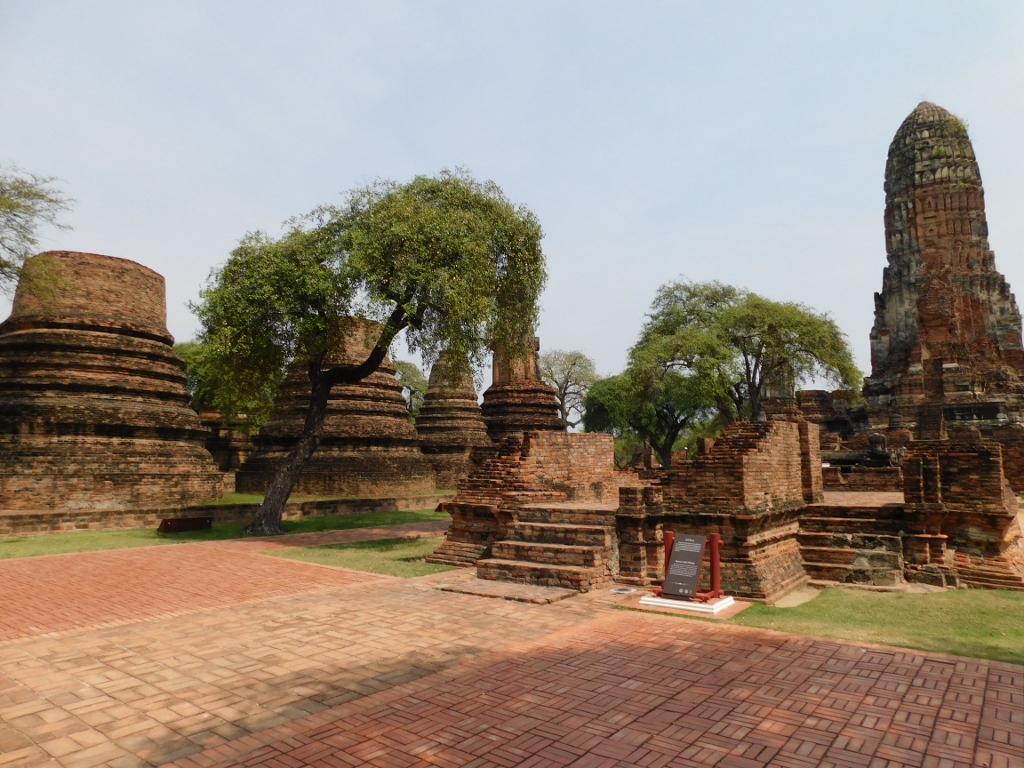 Ayutthaya: Wat Phra Ram
Ayutthaya: Wat Phra Ram
I simply strolled through the entire temple complex, making a circle and eventually returning to the point where I entered.
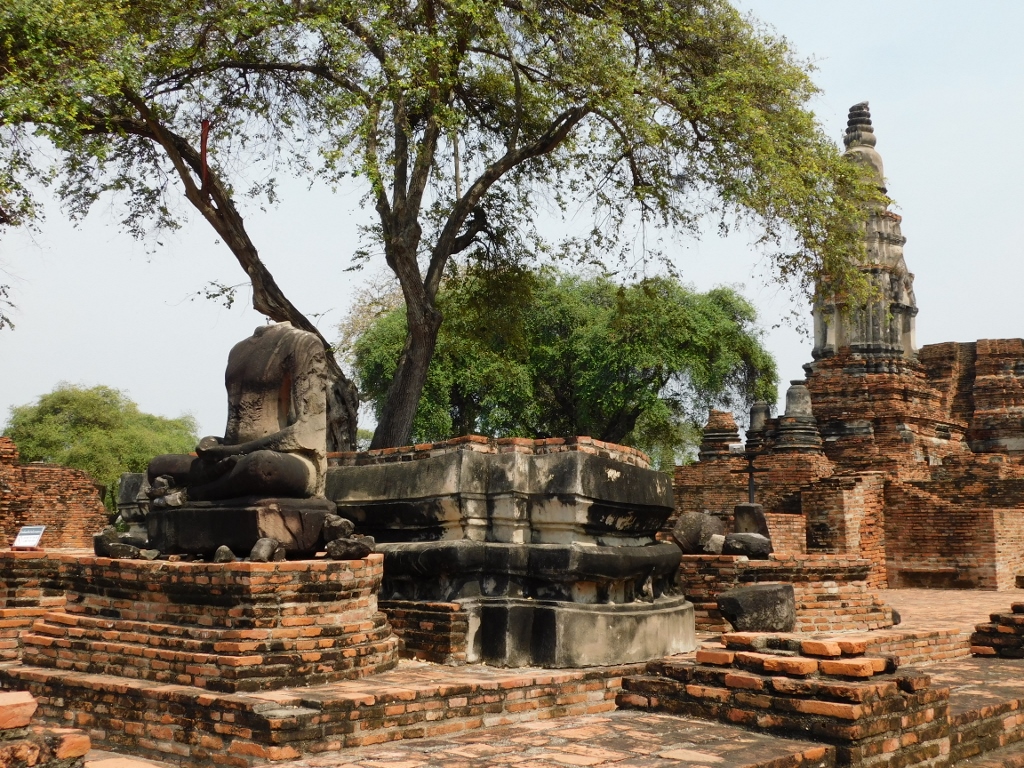 Ayutthaya: Wat Phra Ram
Ayutthaya: Wat Phra Ram
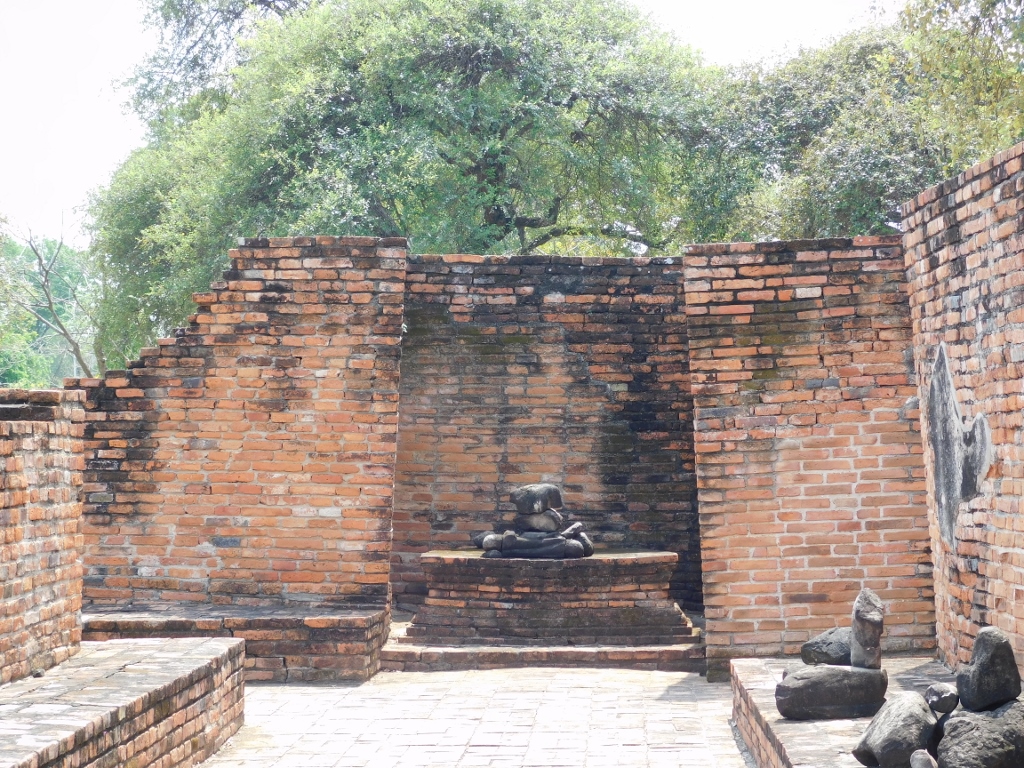 Ayutthaya: Wat Phra Ram
Ayutthaya: Wat Phra Ram
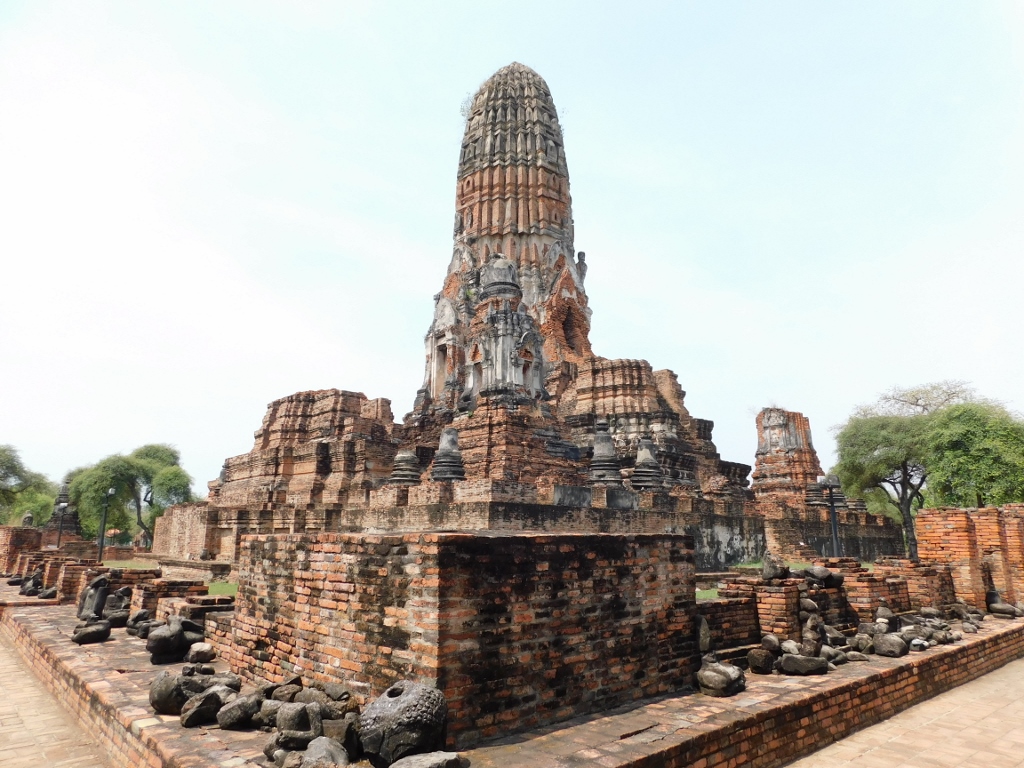 Ayutthaya: Wat Phra Ram
Ayutthaya: Wat Phra Ram
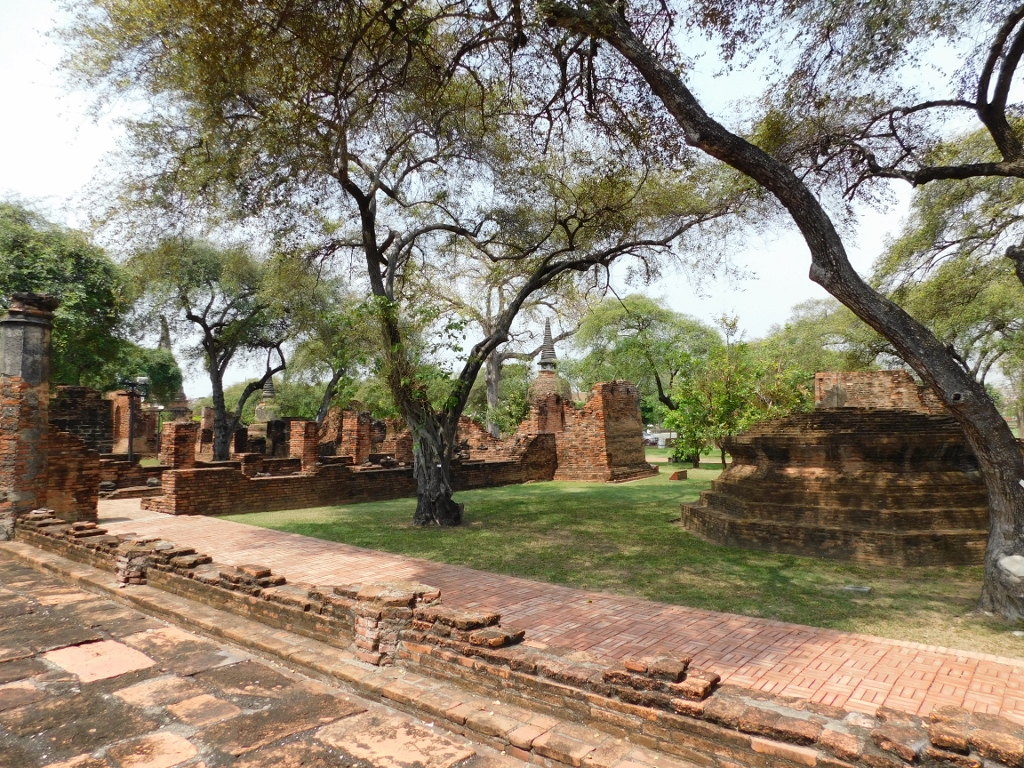 Ayutthaya: Wat Phra Ram
Ayutthaya: Wat Phra Ram
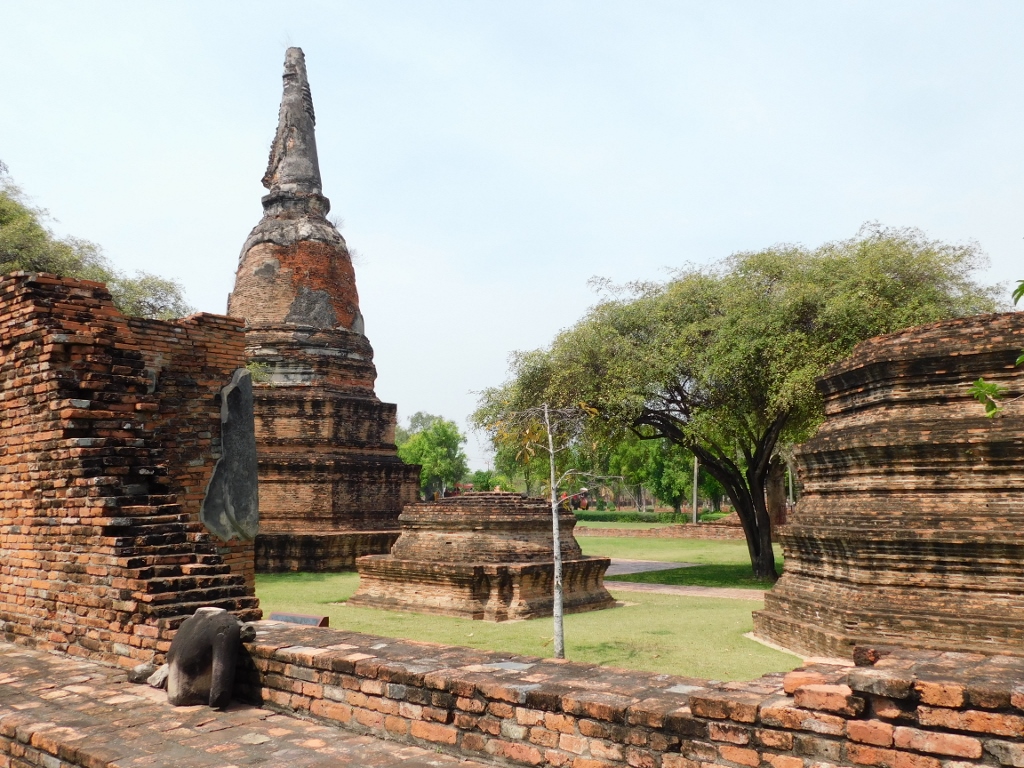 Ayutthaya: Wat Phra Ram
Ayutthaya: Wat Phra Ram
At this point I was still not aware that the museum in Ayutthaya was closed, so I passed by the pond to the south of Wat Phra Ram. It was yet another beautiful sight.
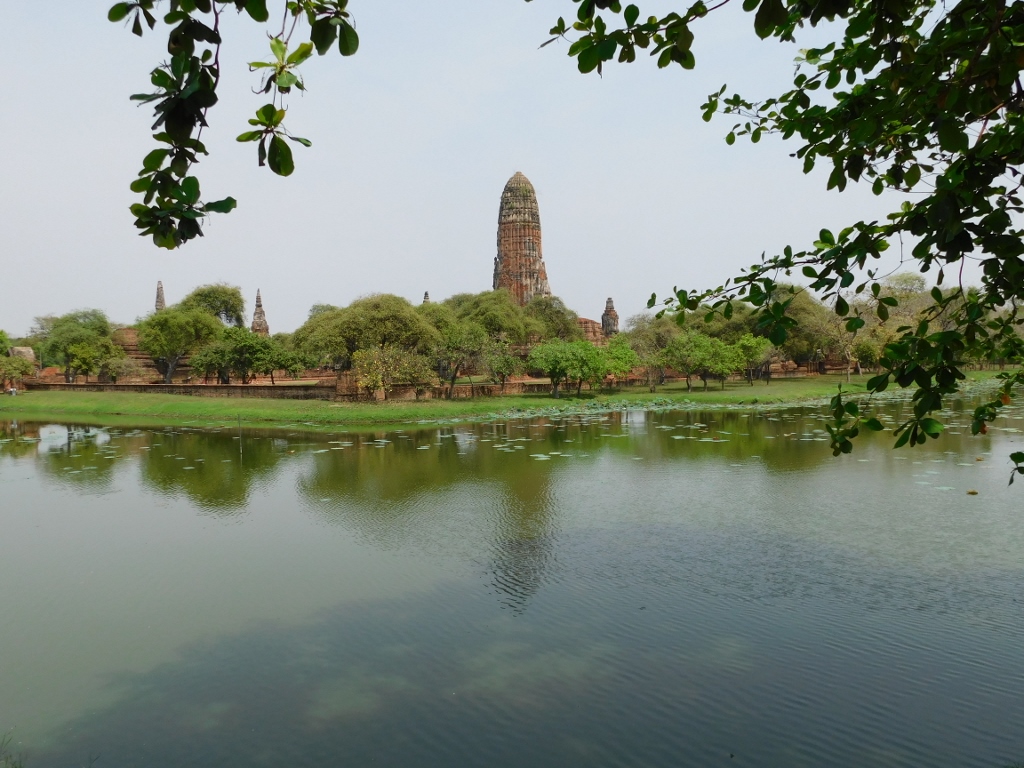 Ayutthaya: Wat Phra Ram
Ayutthaya: Wat Phra Ram
But, as I stood there capturing the pond and the temple, I realised something was moving through the grass not far from me. That’s when I managed to capture an Asian water monitor (Varanus salvator) on camera.
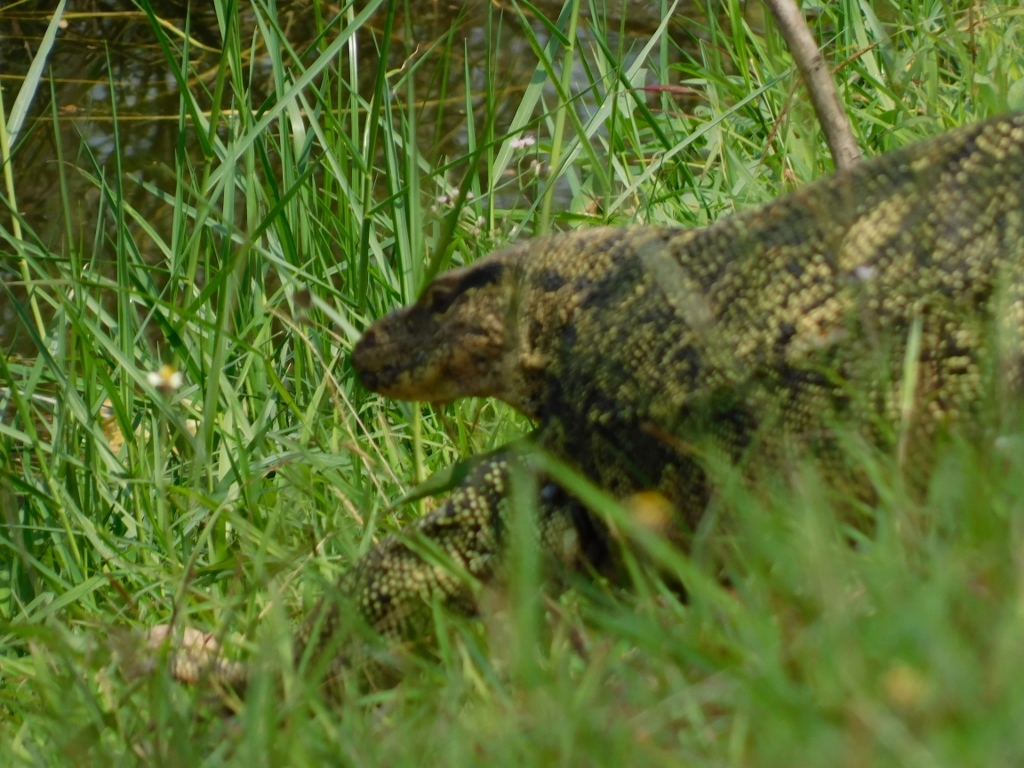 Ayutthaya: a detail
Ayutthaya: a detail
Until now it was quite hot and it had become extremely hot. I dragged myself along the pedestrian path beside the street, occasionally stopping in the shade to capture some interesting details. In Ayutthaya, there are many, many more temples and places to explore, but covering all of them in a single day trip is impossible. On the other hand, I’m not too concerned about this because I did visit the most significant places, plus I’m not knowledgeable enough to find meaning in every detail.
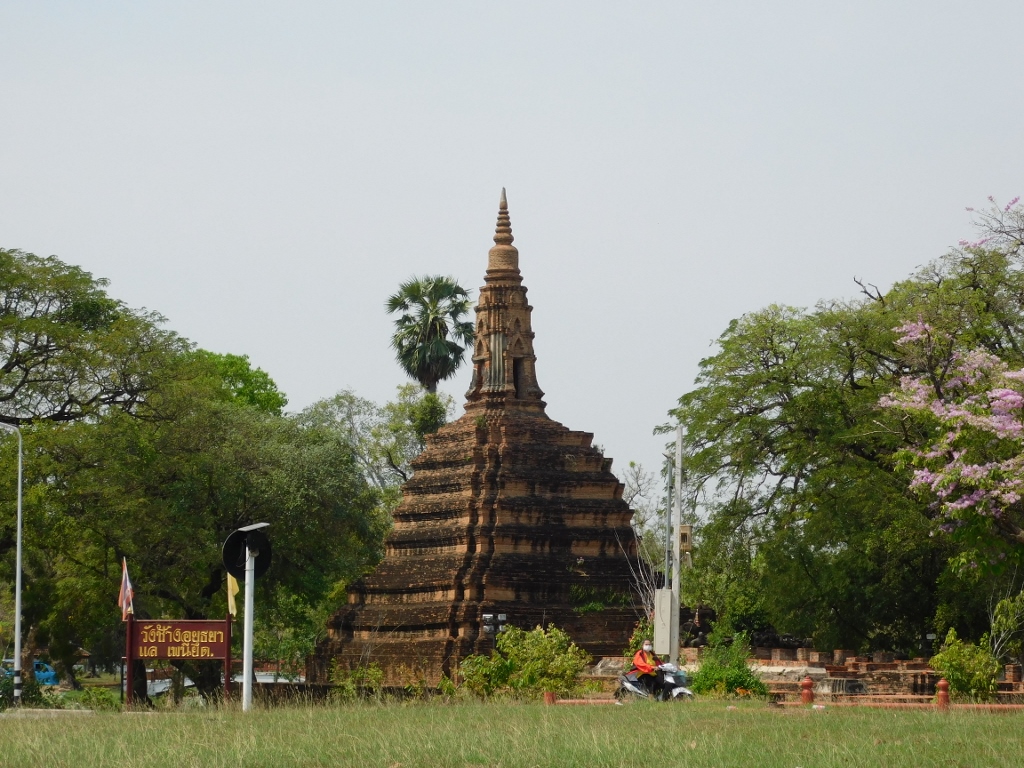 Ayutthaya: Muang Boran Wat
Ayutthaya: Muang Boran Wat
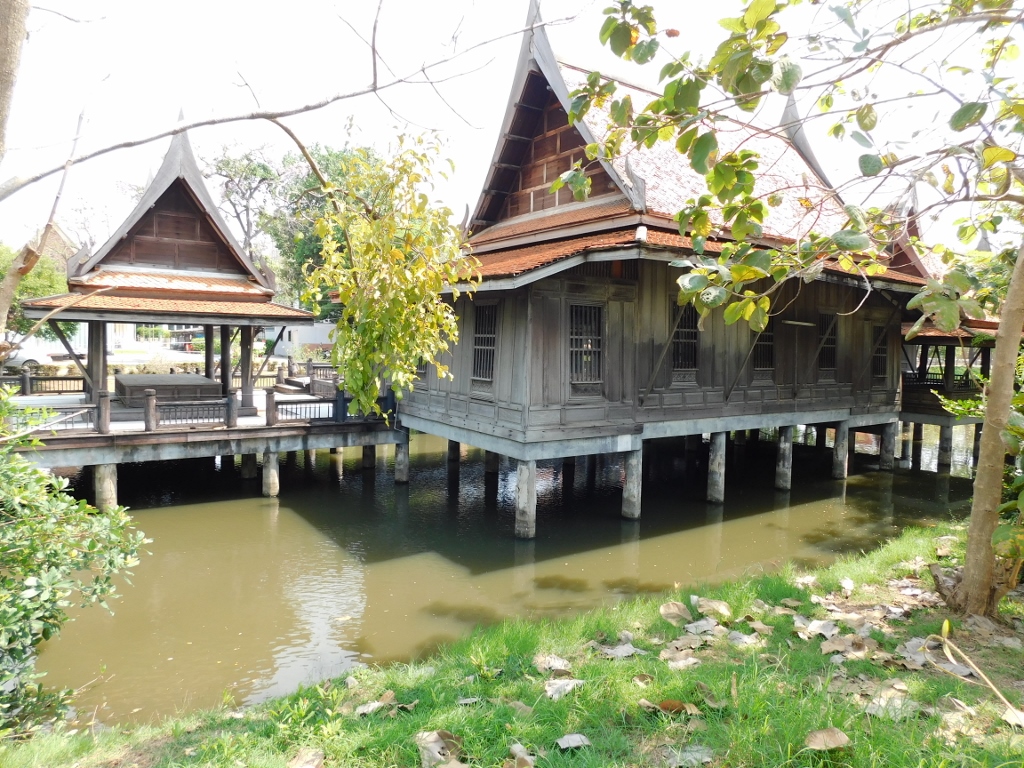 Ayutthaya: a detail
Ayutthaya: a detail
When I finally reached the museum, I realised it was closed on Mondays and it was indeed a Monday. A bit disappointed and somewhat “angry” that I had to come here in the heat for nothing, I sat on a bench in the shade to figure out my next steps. I looked at the map and thought about how to fit in a couple of temples that were not close to each other and in the same direction. Since it was scorching hot and despite drinking a lot of water, I still felt dehydrated. I decided to simply take a taxi to the next destinations. However, easier said than done, as I couldn’t spot a taxi or a tuk-tuk anywhere. I think fate had placed that bench and shade conveniently close to a spot where some people operated motorcycle taxis. Although this form of transportation is common in Bangkok, I didn’t really need it there given the way I did my sightseeing.
All in all, the price they offered me for the ride to the next temple I was interested in seemed fair. I comfortably hopped on the motorcycle behind the driver, enjoying the “wind in my hair” that pleasantly cooled me off. Most importantly, I realised that walking to the farthest temple would have been nearly impossible. Maps don’t provide a realistic representation because the distance can’t be covered directly – you need to navigate through various streets.
When I reached the desired temple, Wat Chai Watthanaram, satisfied with the ride, I even tried to explain to the driver that I needed about 20 minutes to explore and then I would continue, but he didn’t want to wait. Fair enough. Then I started with my exploration.
The Wat Chai Watthanaram temple is located outside the island where most of Ayutthaya is situated. This is one of the first things a visitor becomes aware of, as they have to cross a large bridge over the Chao Phraya River. After a short drive through a modern settlement, you reach a ticket booth. Once you purchase your ticket, you enter the area of the temple complex.
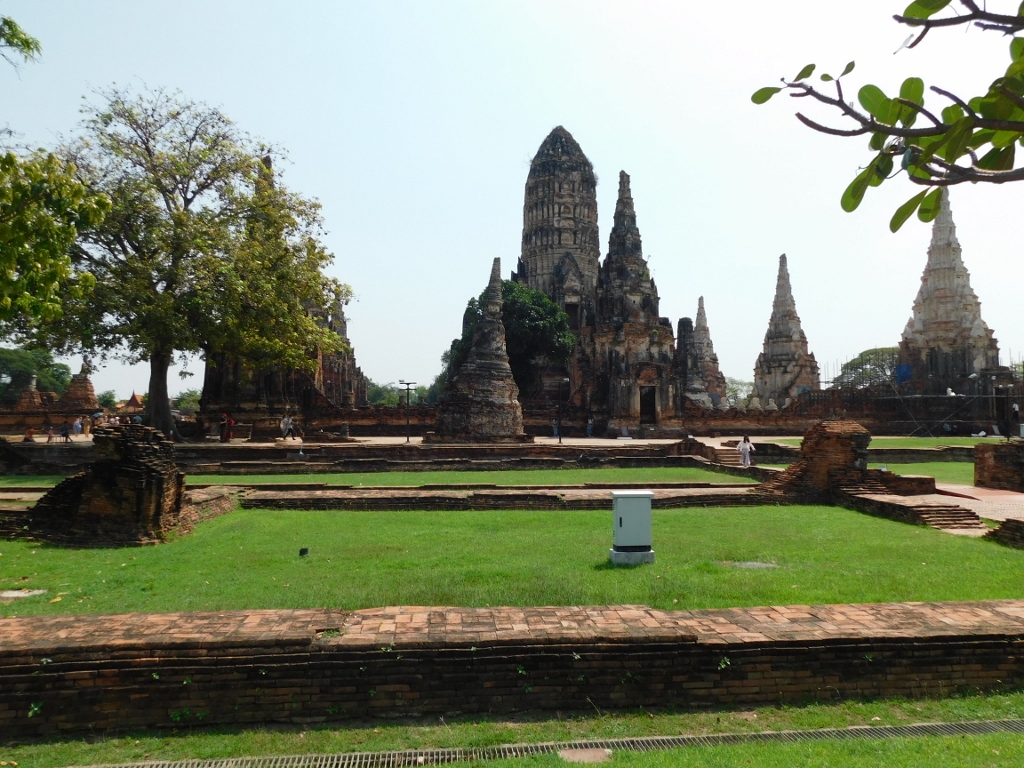 Ayutthaya: Wat Chai Watthanaram
Ayutthaya: Wat Chai Watthanaram
This was once a royal temple complex and its construction began in 1630, lasting for about two decades. It was built by the then king of Ayutthaya in honour of his mother, using the famous Angkor Wat in Cambodia as a model. The central tower, the prang, that I’ve already mentioned as an architectural element, originated in the Khmer Empire (802-1431) and from there it was adopted by the builders of the Siamese kingdoms of Ayutthaya and Rattanakosin.
Here, the central prang, standing at 35 meters, is well-preserved and rises above all other elements. It is surrounded by a square-shaped cloister, i.e., originally a covered porch. At the corners and in the middle of each side of the cloister, there are stupas or chedis. Individual chedis or their remains can also be seen on the external side of the cloister. There are no viharas, but there is an ubosot.
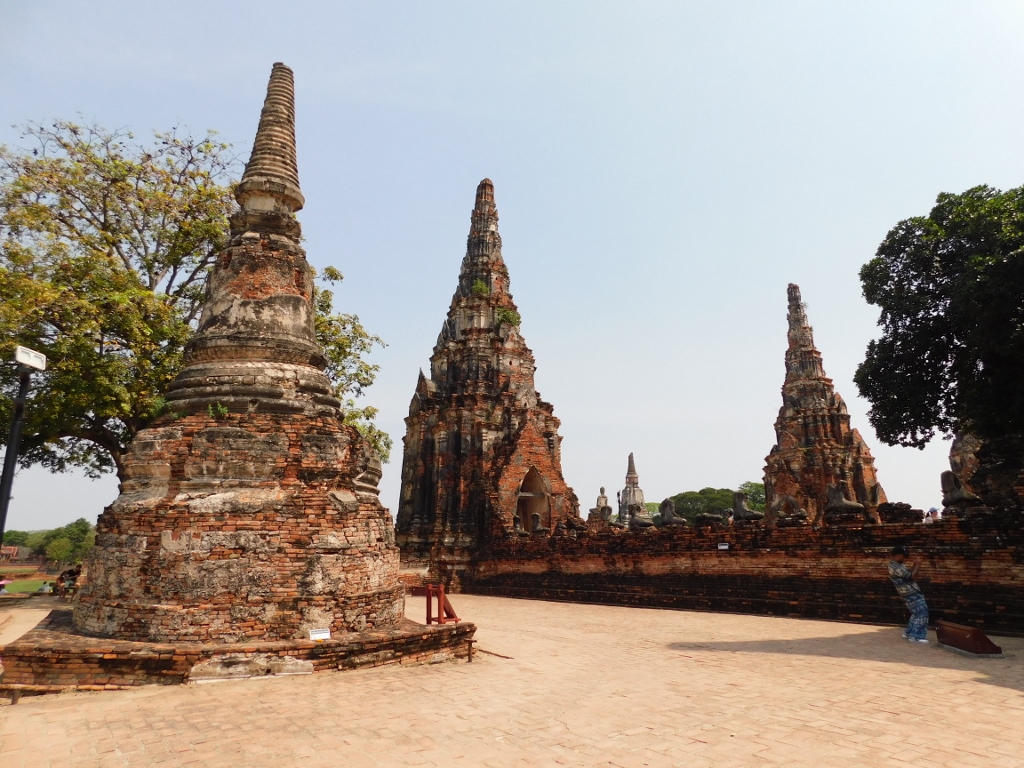 Wat Chai Watthanaram: an individual chedi in the foreground, with two chedis built along the cloister
Wat Chai Watthanaram: an individual chedi in the foreground, with two chedis built along the cloister
All of that can be explored quite nicely and the only challenge for me was the heat and the intense sun. I wasn’t the only one seeking shade.
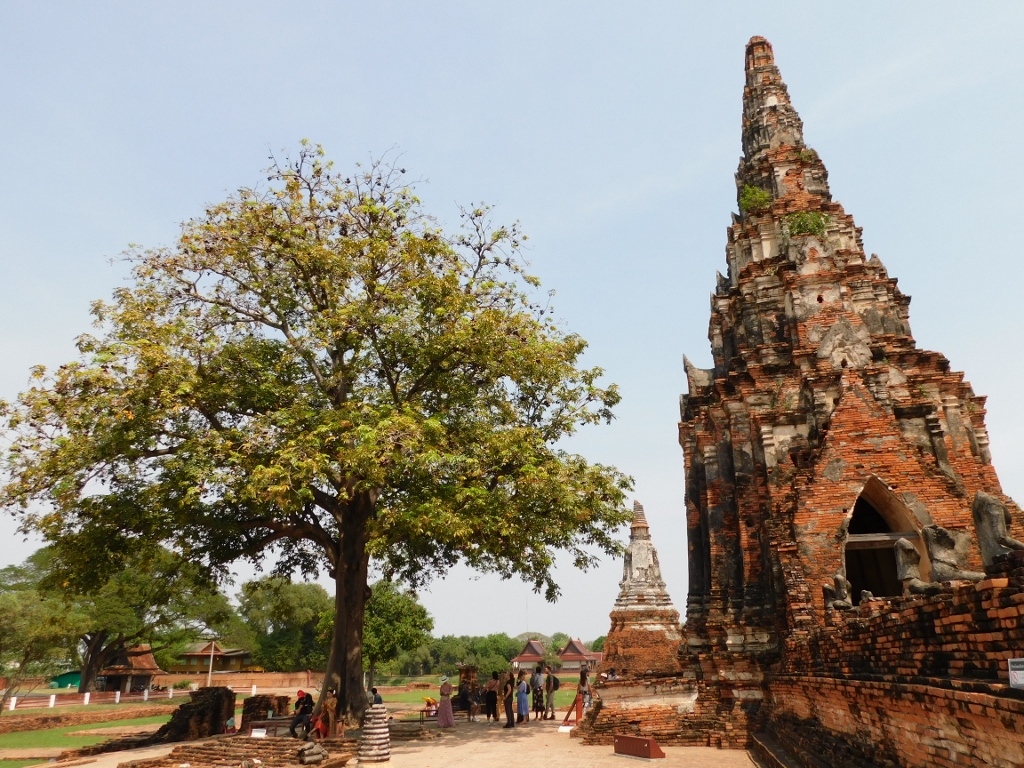 Ayutthaya: Wat Chai Watthanaram
Ayutthaya: Wat Chai Watthanaram
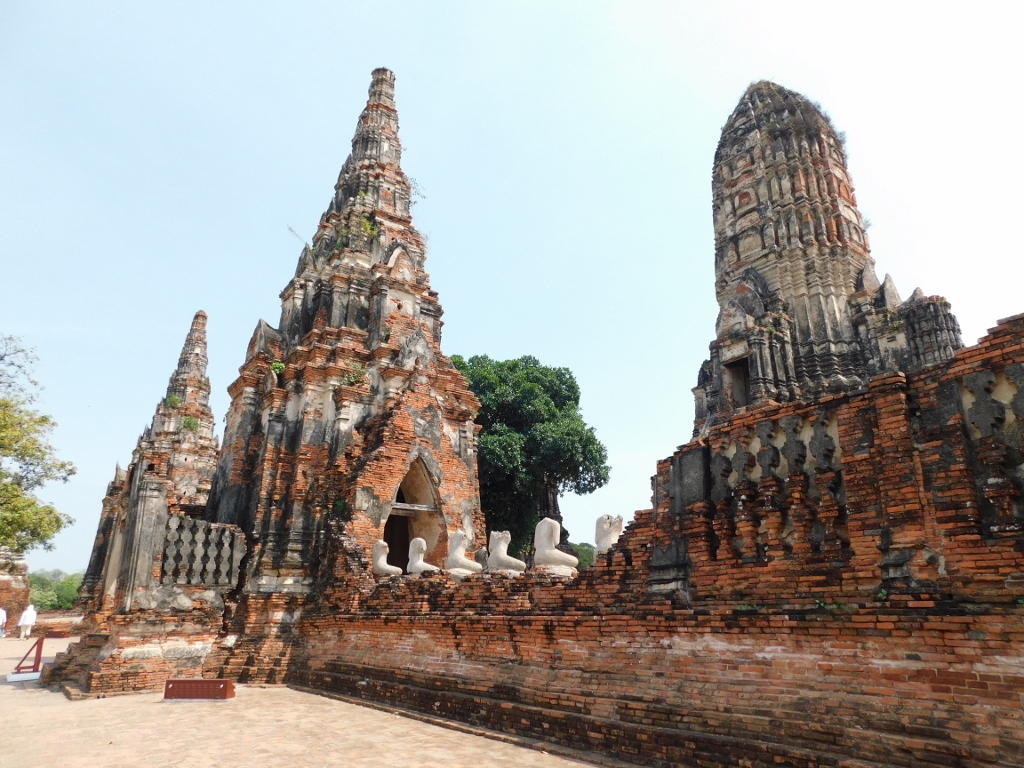 Wat Chai Watthanaram: the front side of the cloister
Wat Chai Watthanaram: the front side of the cloister
I first started to circle around the monastery in a clockwise direction, so I immediately noticed the decoration done on the back side of the chedis standing at the corners of the monastery. Although quite eroded, it depicts various scenes from the Buddha’s life.
For instance, in the next photo, you can see three levels in this stucco relief panel. Not everything is discernible, but in the middle part, three rows of angels praying in a kneeling position can be noticed. In the upper part, there are numerous details, with the central figure being the Buddha standing on a pedestal in the form of lotus petals.
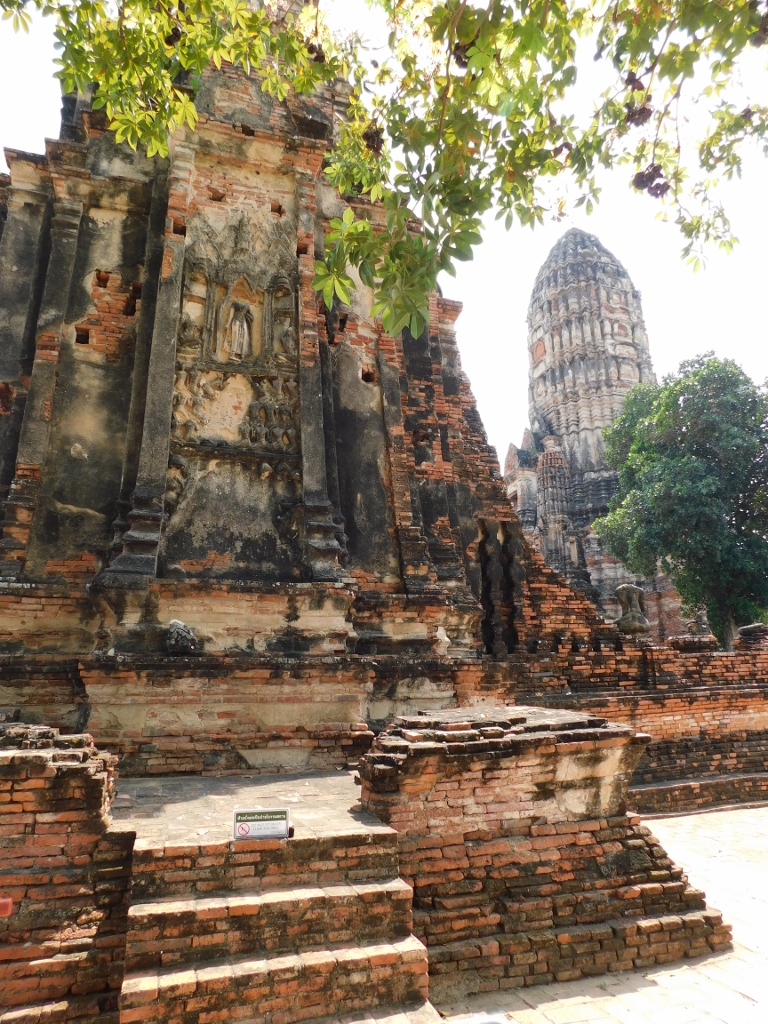 Wat Chai Watthanaram, northeastern chedi
Wat Chai Watthanaram, northeastern chedi
Next, I reached the ubosot located east of the central prang and outside the cloister. Today, only the foundations of the ubosot are visible, but there are also two pedestals on the western side of the structure on which figures of the Buddha in a meditation pose have been placed.
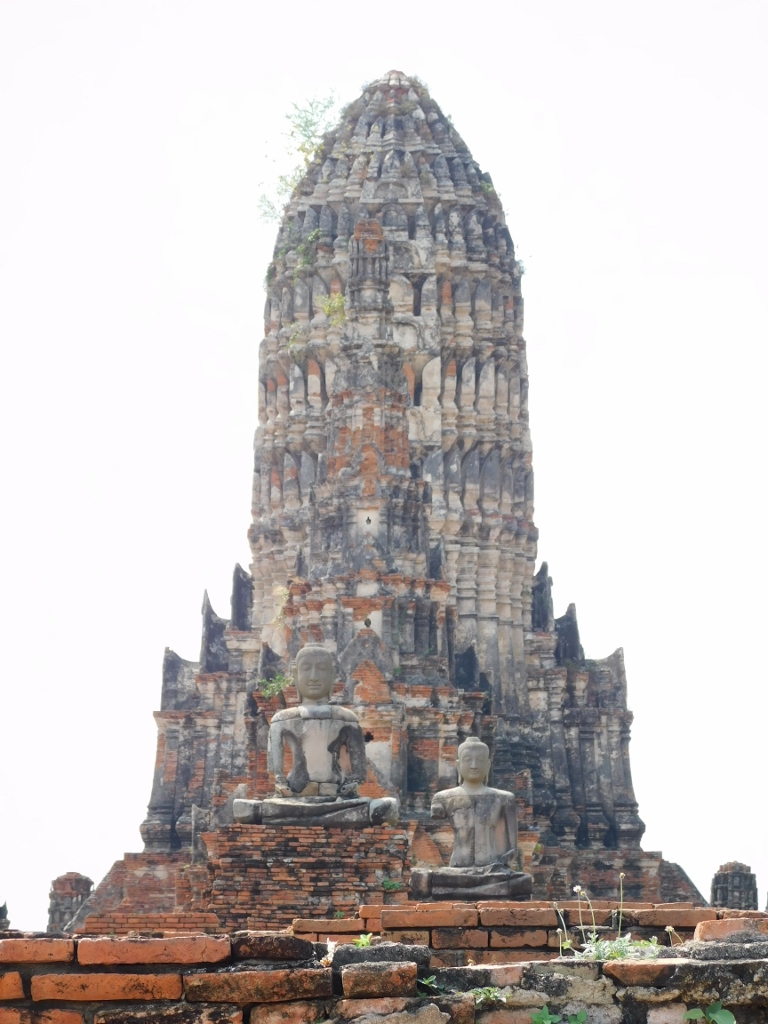 Wat Chai Watthanaram, a detail
Wat Chai Watthanaram, a detail
From here, there is also a very beautiful view of the Chao Phraya River flowing peacefully beside the temple.
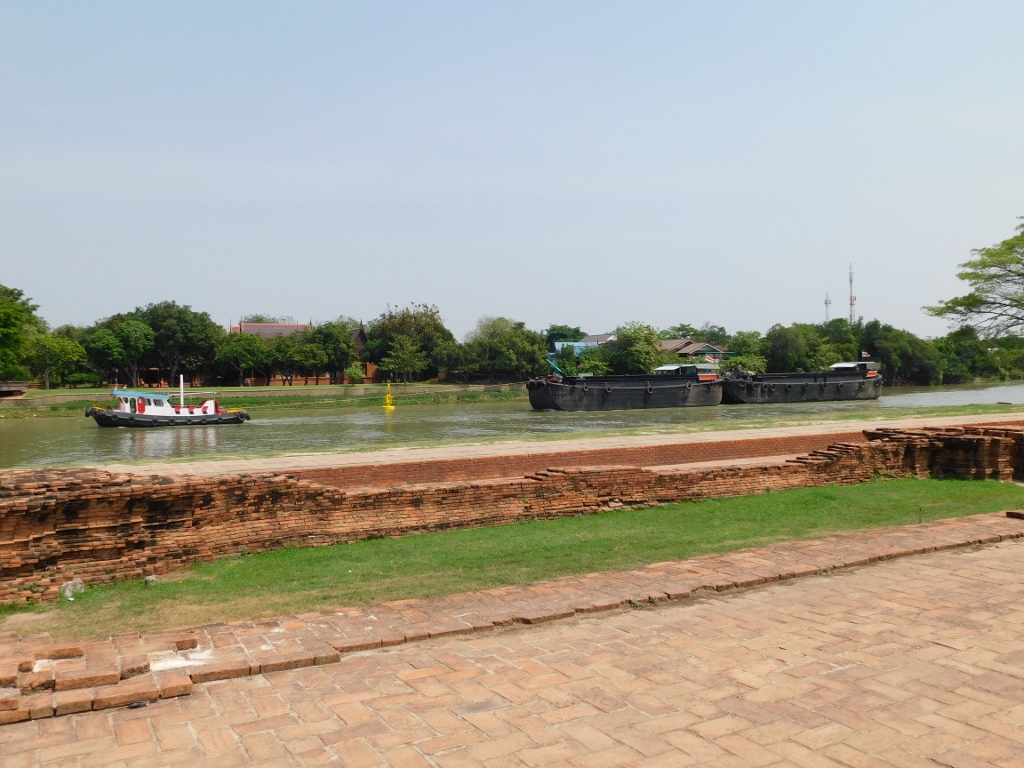 The Chao Phraya river runs beside the Wat Chai Watthanaram temple
The Chao Phraya river runs beside the Wat Chai Watthanaram temple
Now I refocused my attention on the temple complex and I continued with my sightseeing.
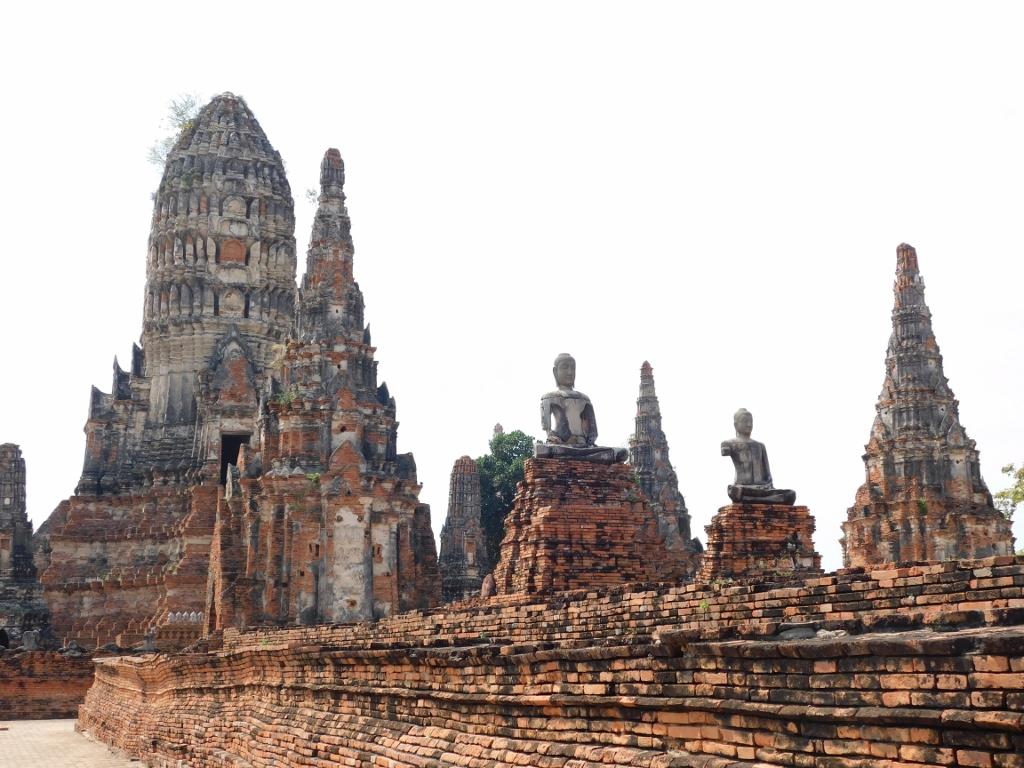 Wat Chai Watthanaram, remains of the ubosot are in the foreground
Wat Chai Watthanaram, remains of the ubosot are in the foreground
Thus I reached the southwest exterior side of the cloister and then I entered the inner part surrounded by the cloister.
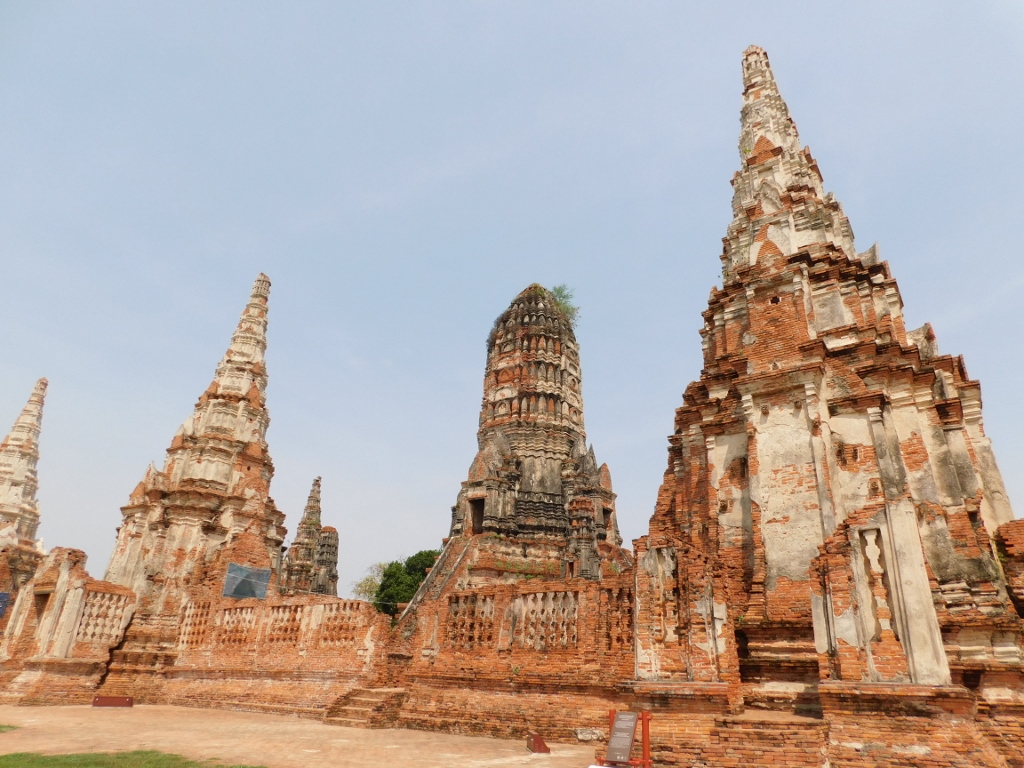 Wat Chai Watthanaram, a detail
Wat Chai Watthanaram, a detail
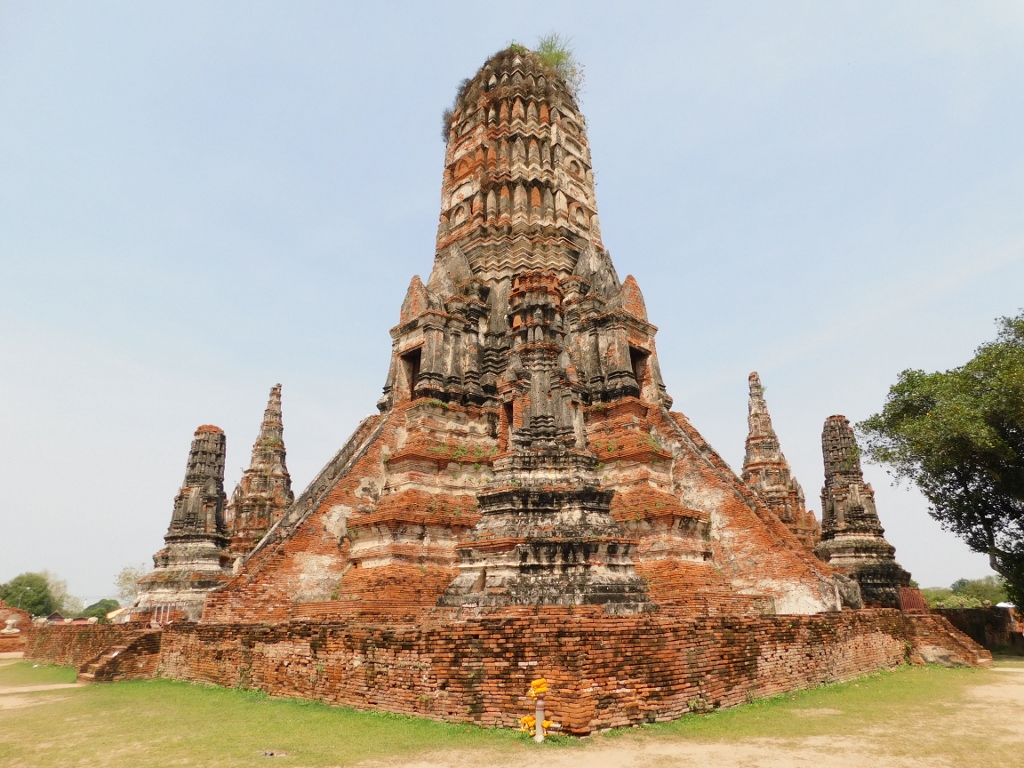 Wat Chai Watthanaram, a detail
Wat Chai Watthanaram, a detail
When observing the tall central prang, it’s easy to overlook the fact that there are also four smaller prangs at the corners of the structure. This is an element typical of the Khmer Empire architecture. At one of the smaller prangs, I also came across a kind of parasol that made the scene even more interesting.
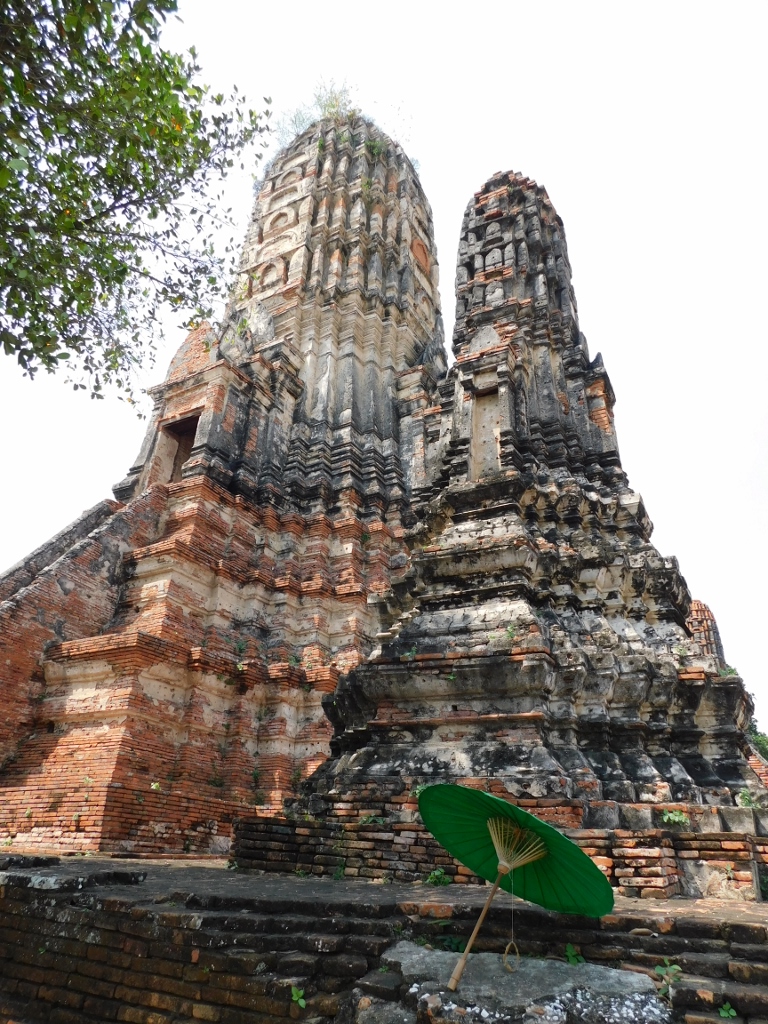 Wat Chai Watthanaram, a detail
Wat Chai Watthanaram, a detail
Here, I also noticed a Pallas’s squirrel (Callosciurus erythraeus) happily hopping around the remains of the old temple.
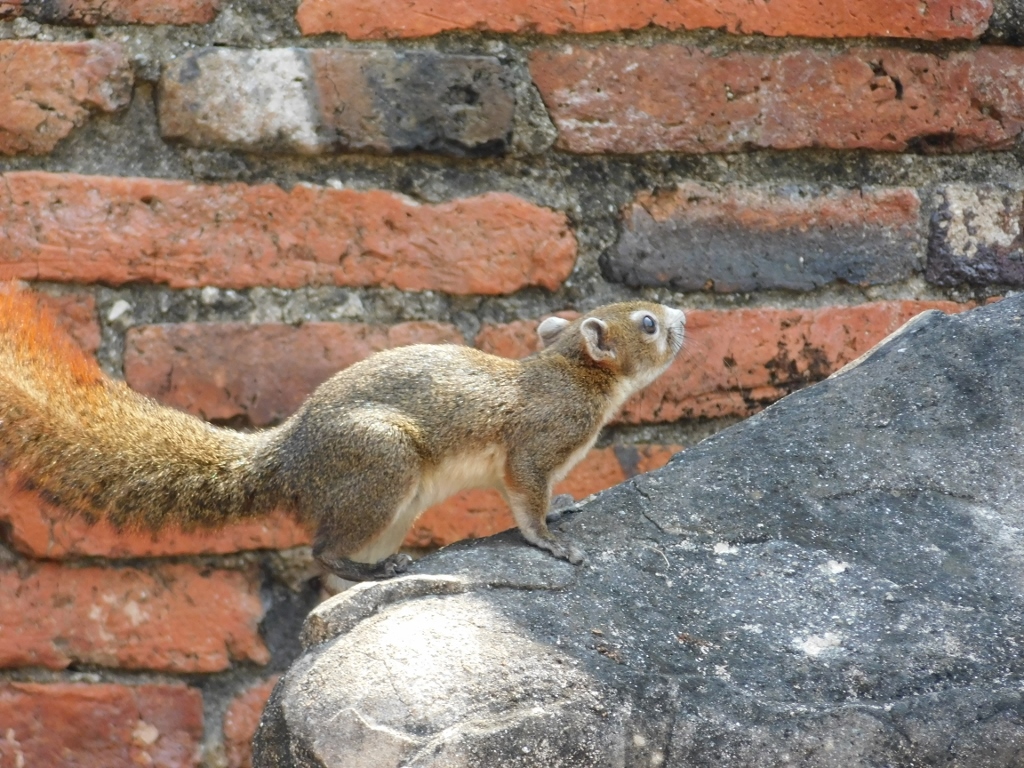 Pallas’s squirrel
Pallas’s squirrel
But, as my main goal was to explore the temple, after a brief pause to take a photo of the small rodent, I continued walking around the cloister. From there, I could see not only the Buddha figures that traditionally adorn these covered walkways in various temples, but also a couple of large chedis flanking the ubosot.
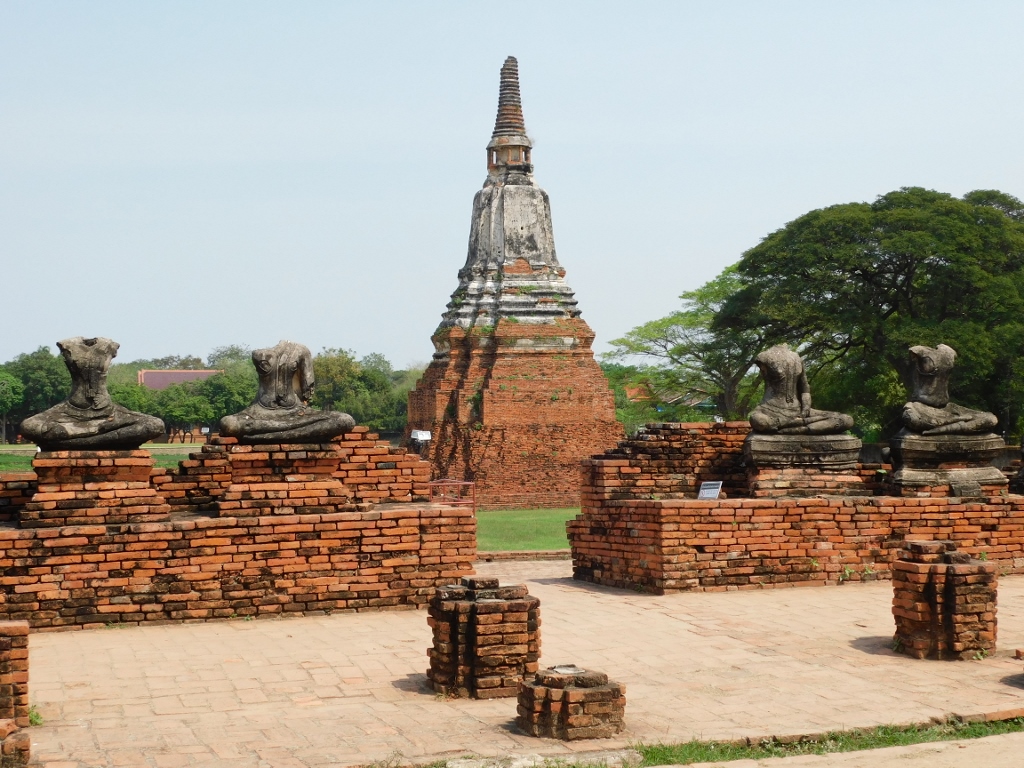 Wat Chai Watthanaram, a detail
Wat Chai Watthanaram, a detail
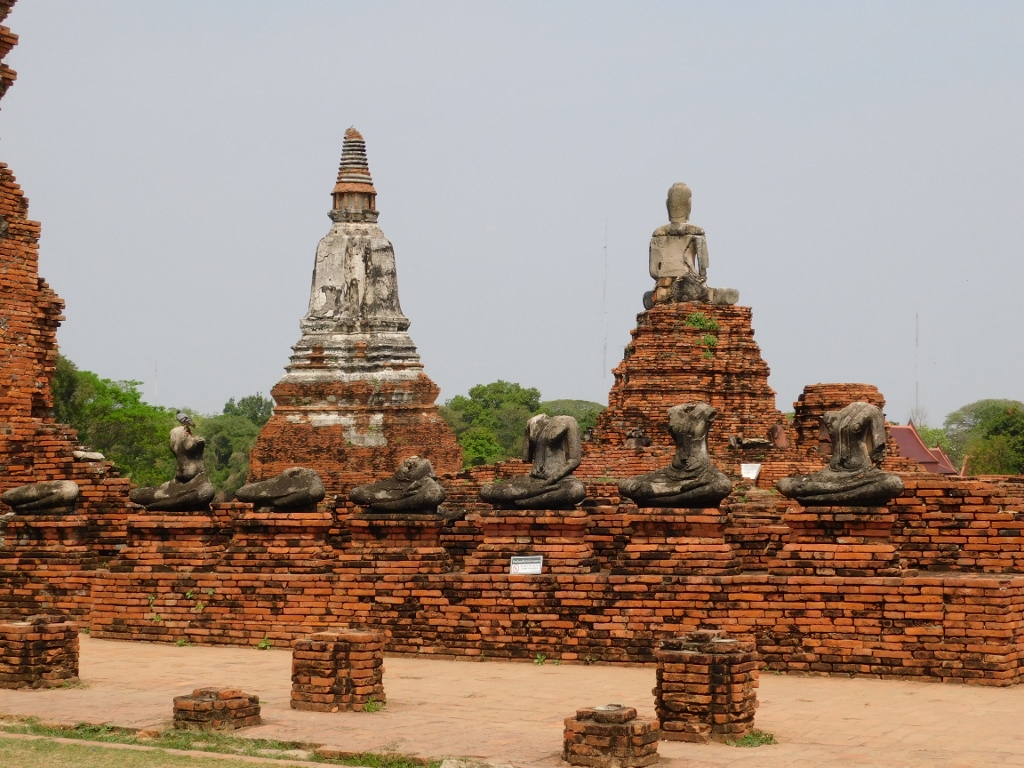 Wat Chai Watthanaram, a detail
Wat Chai Watthanaram, a detail
By the way, one can pass through the chedis erected along the cloister and, within them, there are shrines that believers continue to visit and pay homage to.
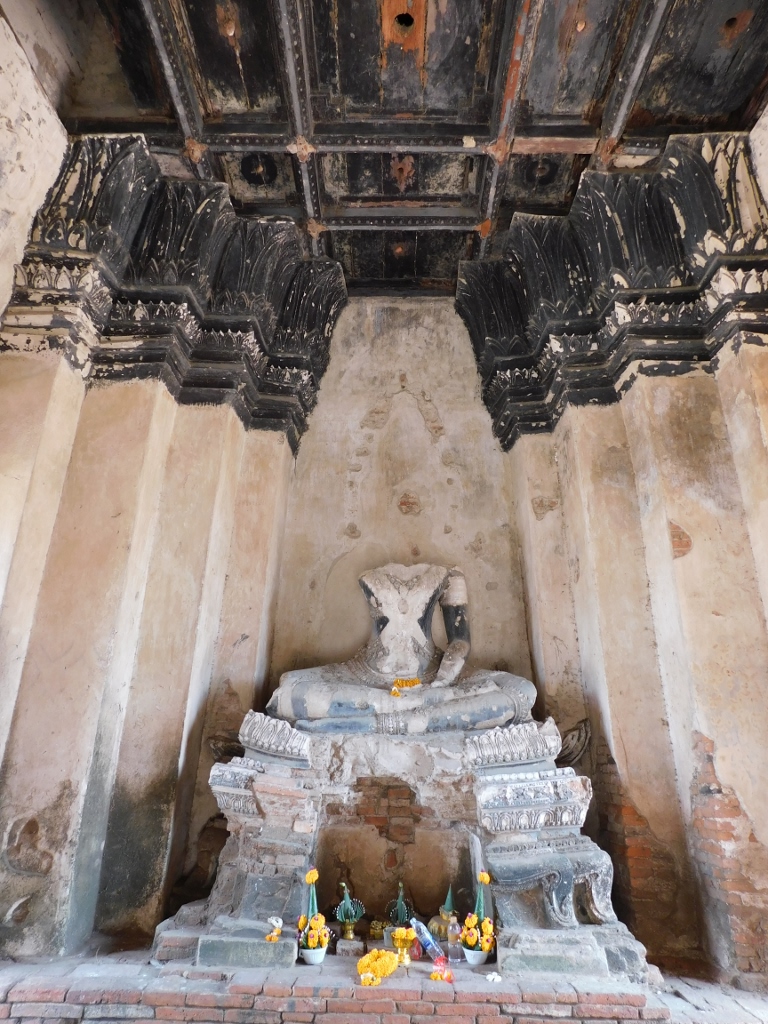 Wat Chai Watthanaram, a detail
Wat Chai Watthanaram, a detail
I also took a photo of the central prang from the front and then I could leave the site.
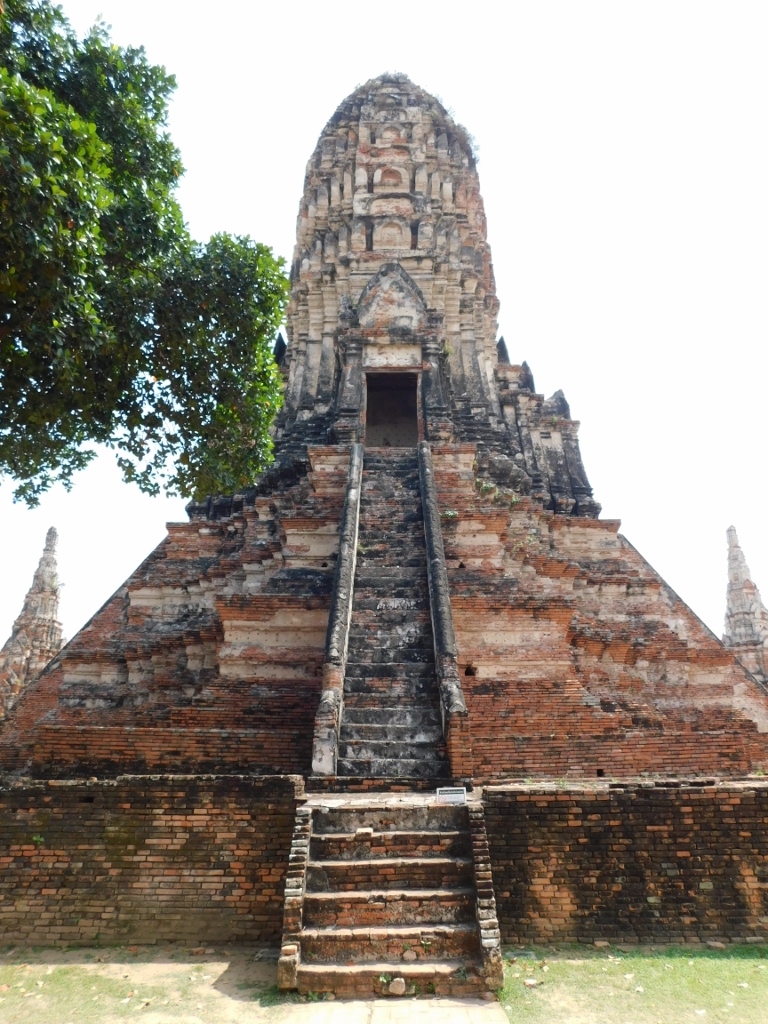 Wat Chai Watthanaram, a detail
Wat Chai Watthanaram, a detail
After the sightseeing of this temple, I stopped by a shop across the entrance to buy more water since I had depleted my supplies incredibly quickly. I didn’t see any motor-taxis around, so I tried to inquire with two women working in the shop. In Thailand, people speak very little, if any, English and the communication can be challenging despite it being a noticeably touristy country. Nonetheless, these two women somehow understood what I needed, even how far I needed to go by the motor-taxi, so one of them called it for me. Soon, the driver arrived. The service was perfect. On this occasion, I gathered the courage to record a bit of the ride, but I didn’t overdo it – I still needed to be stable on the motorbike and not worry about my phone potentially slipping from my hand.